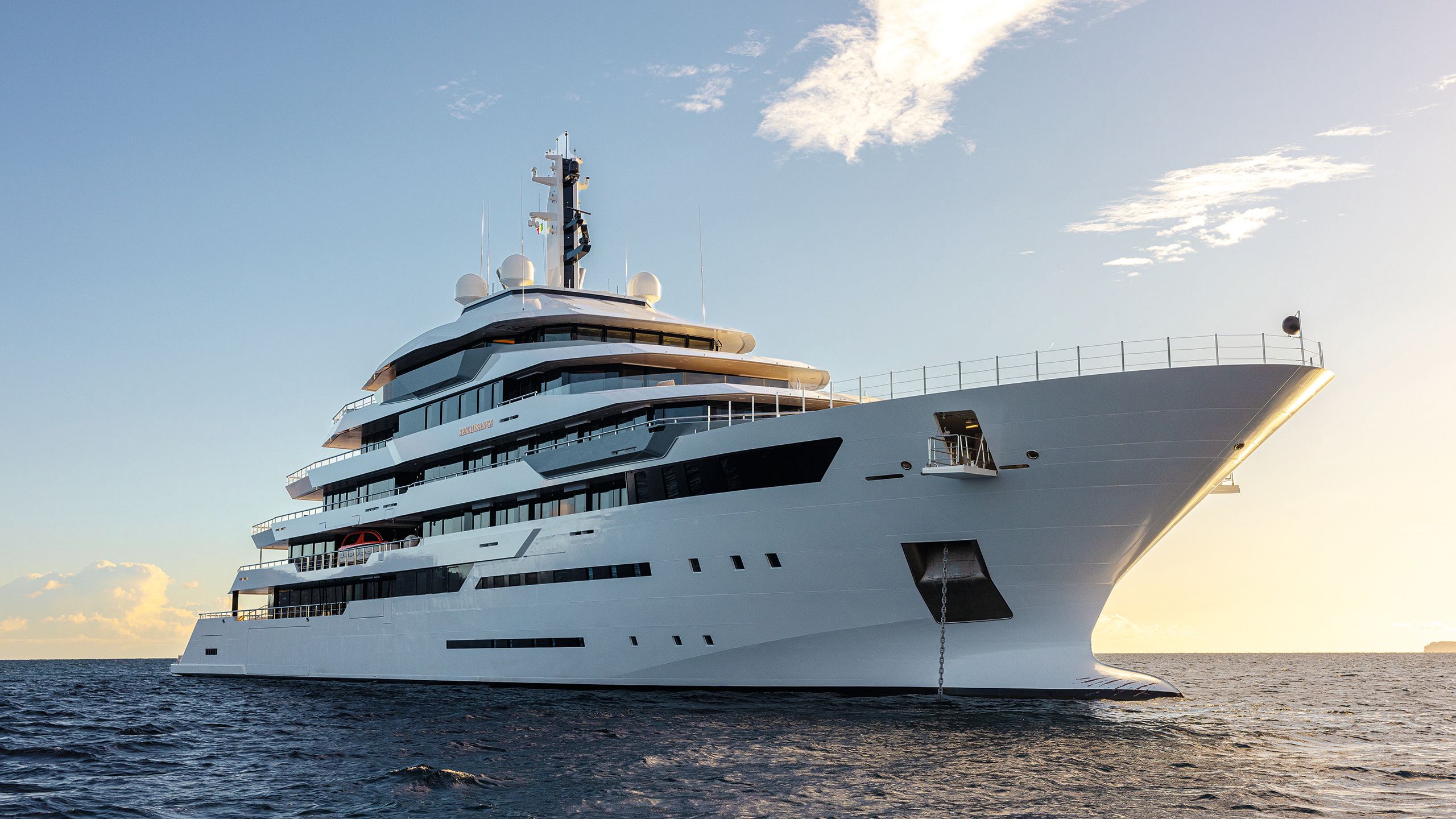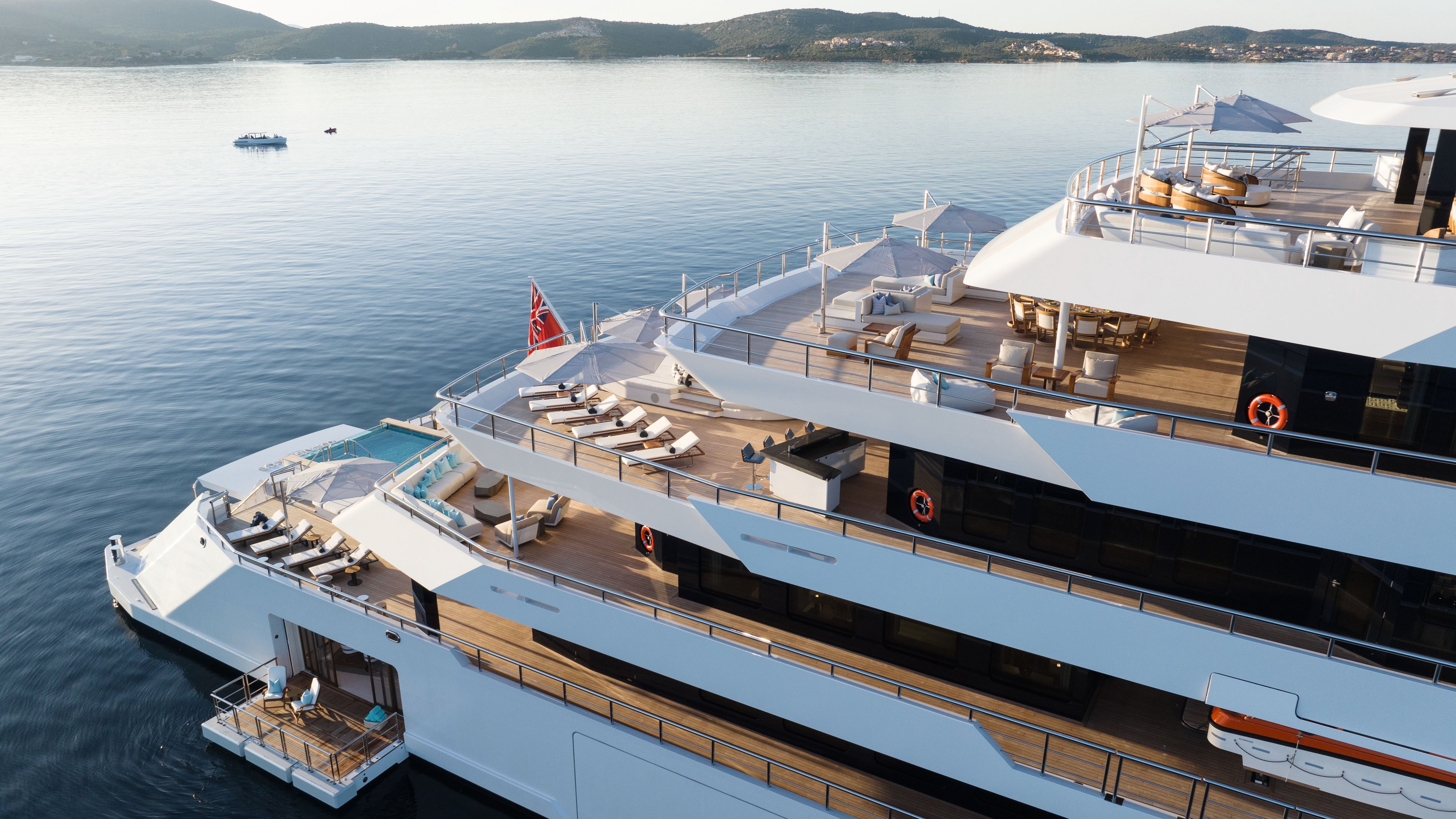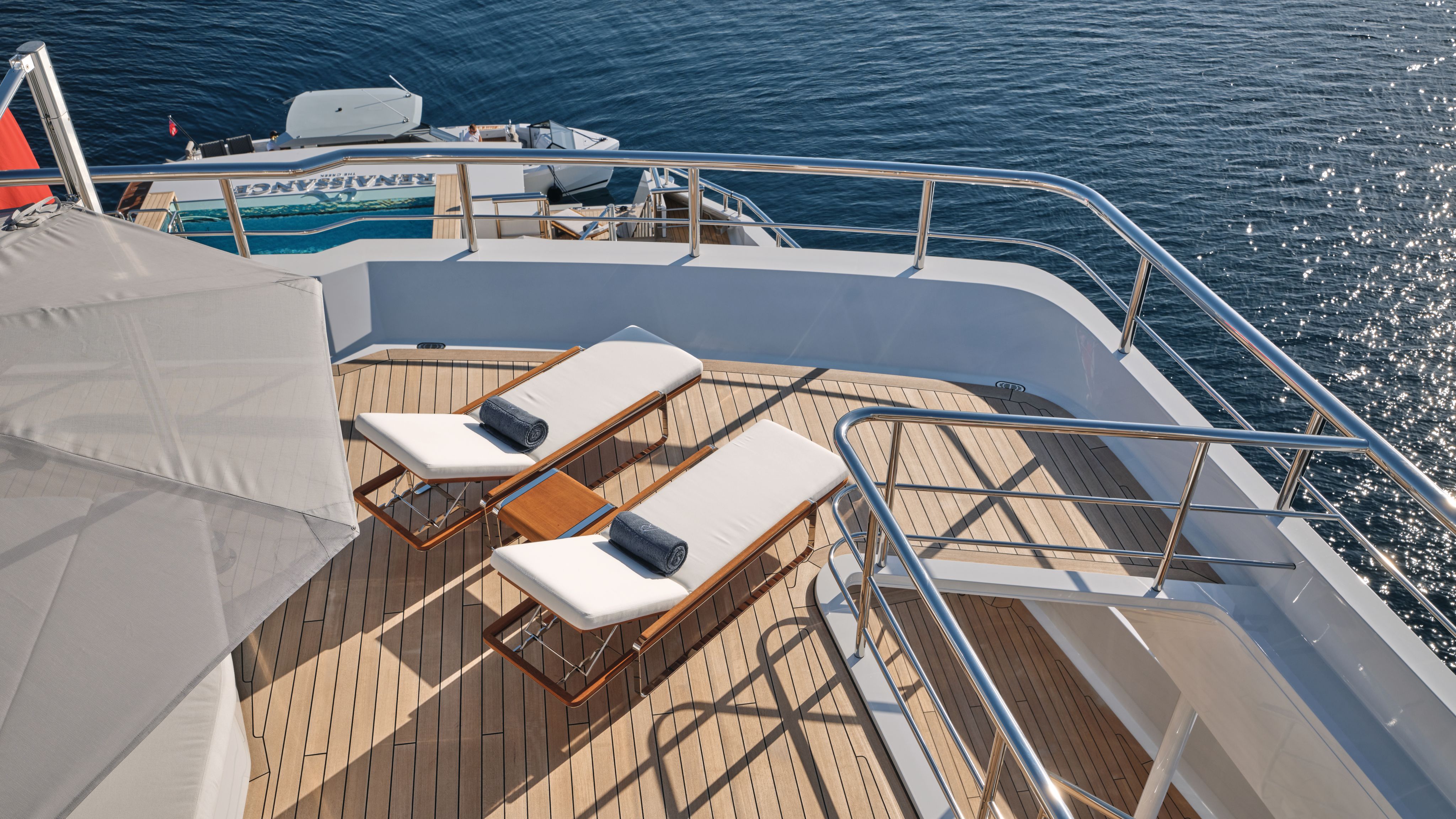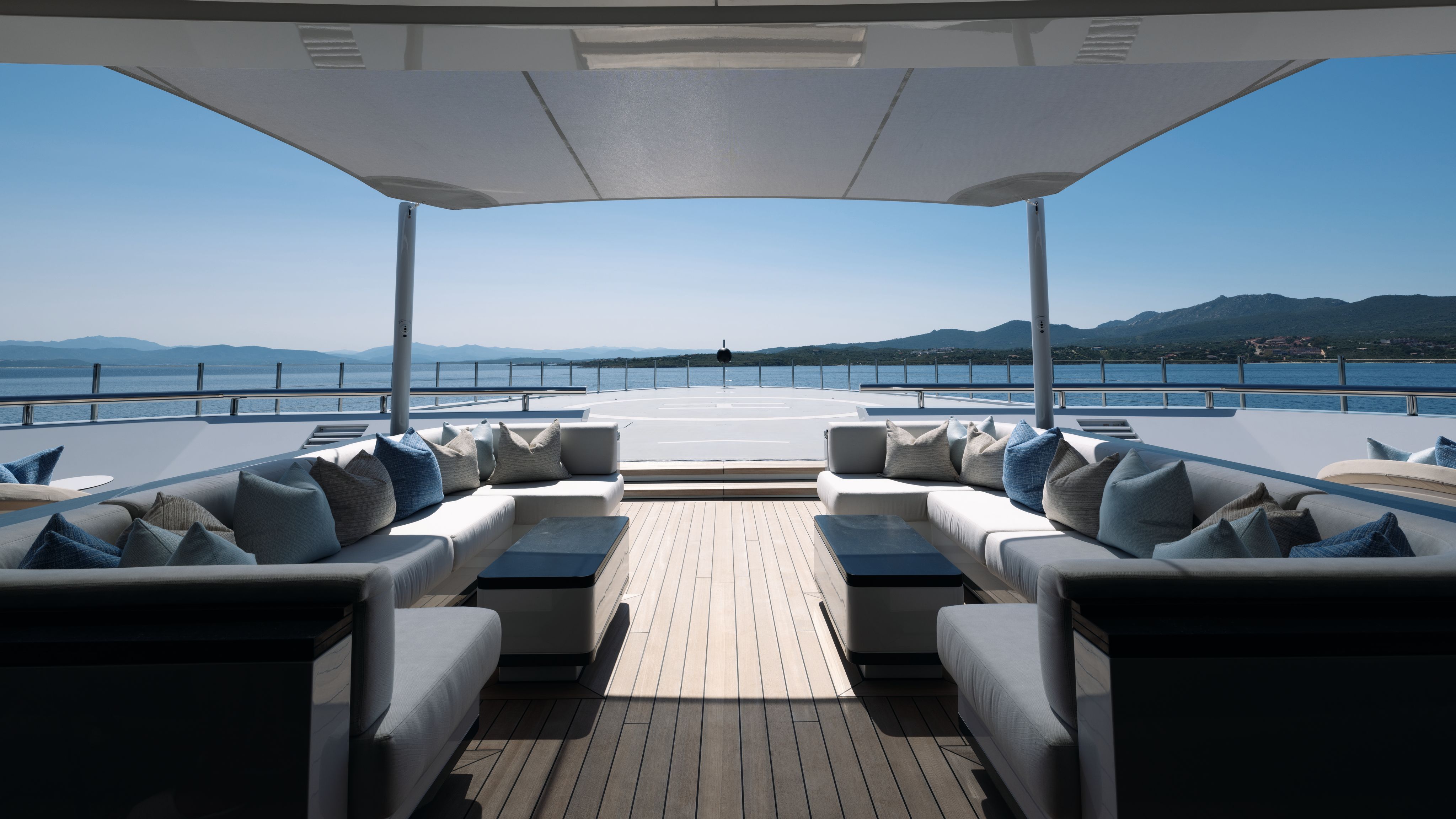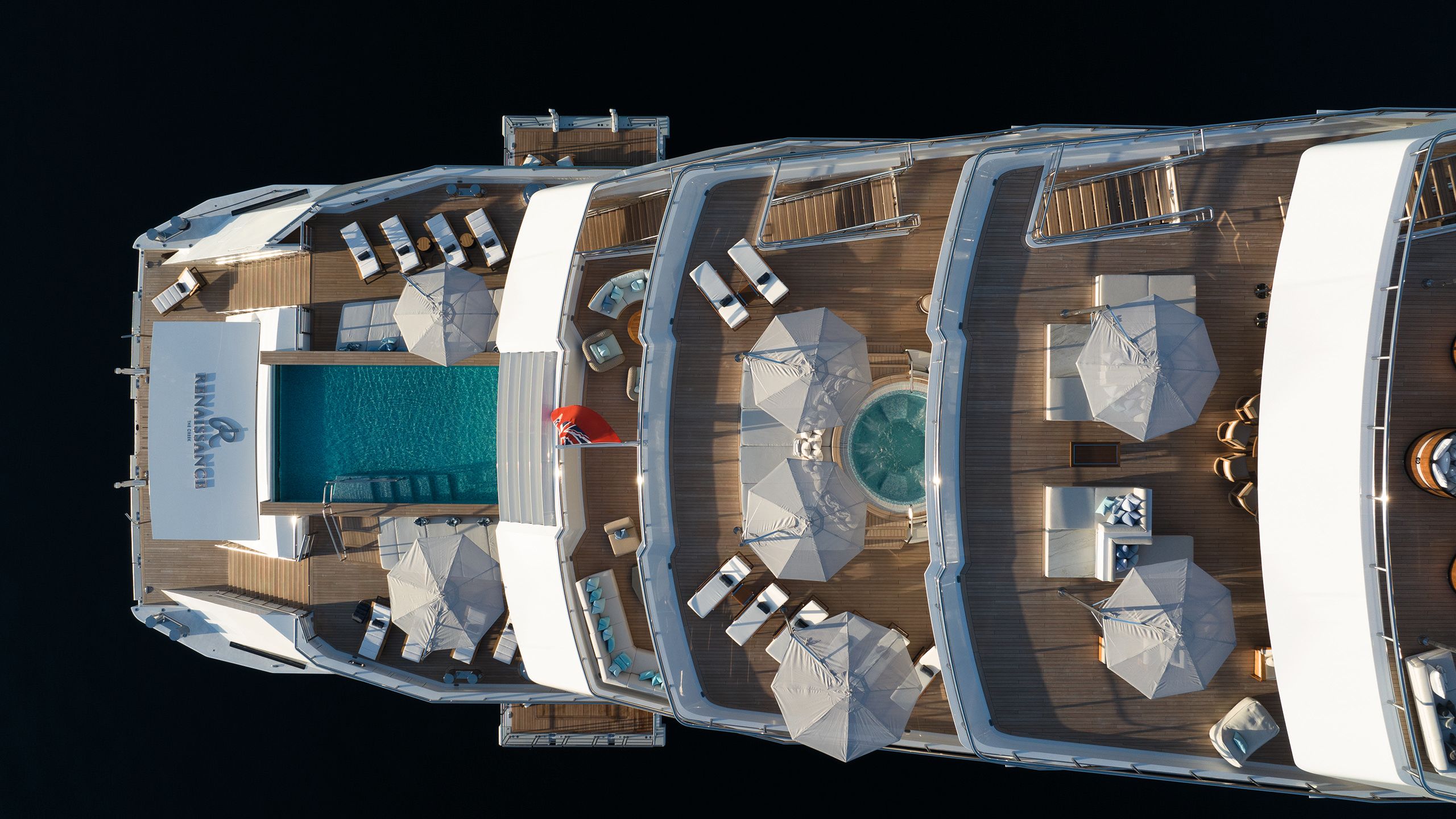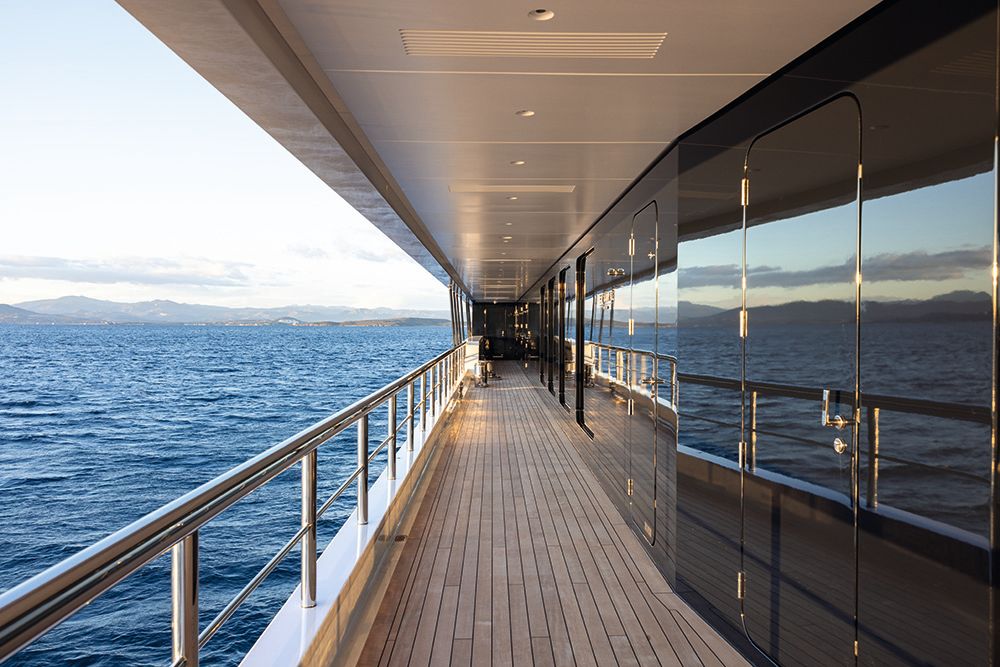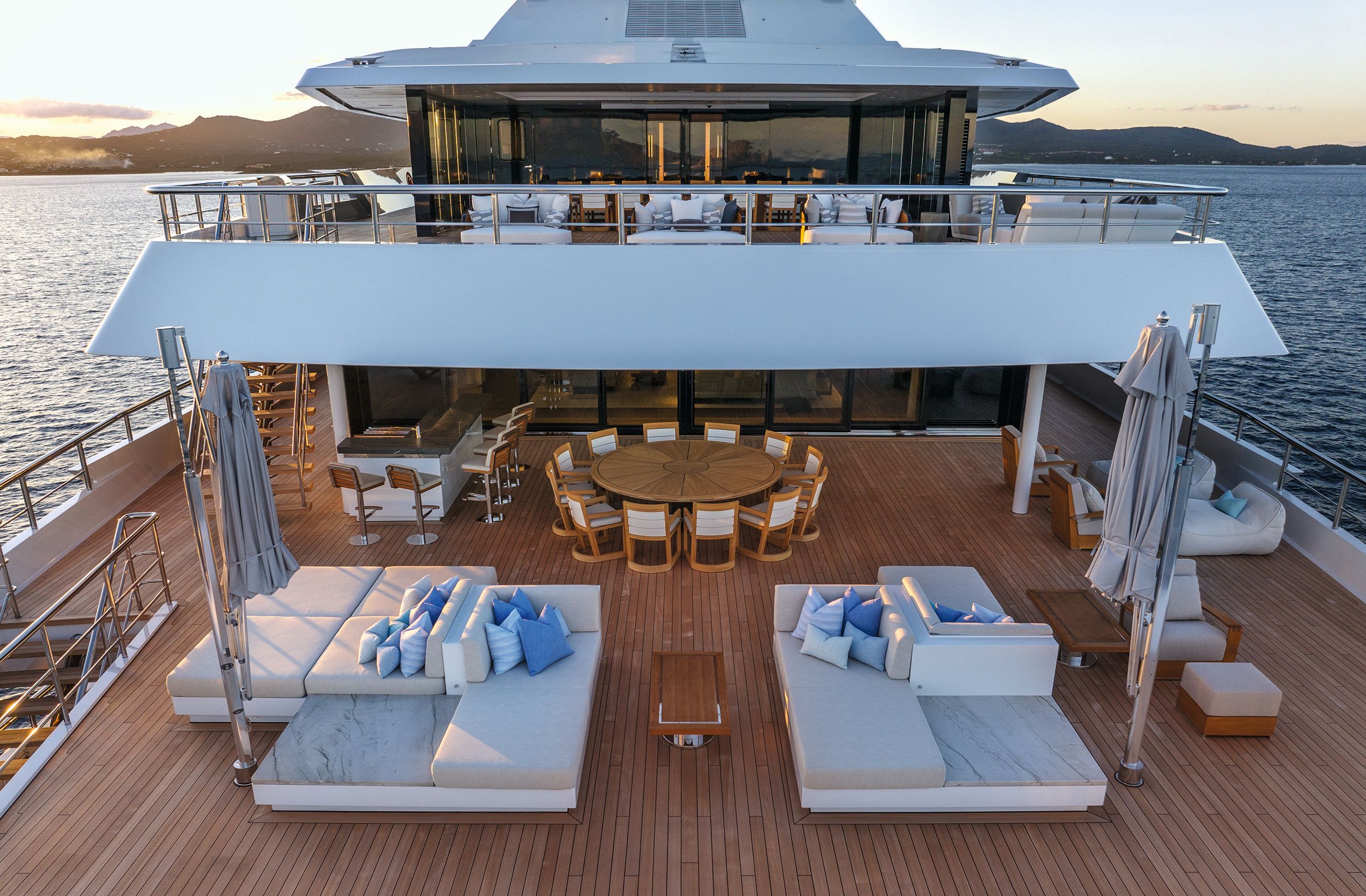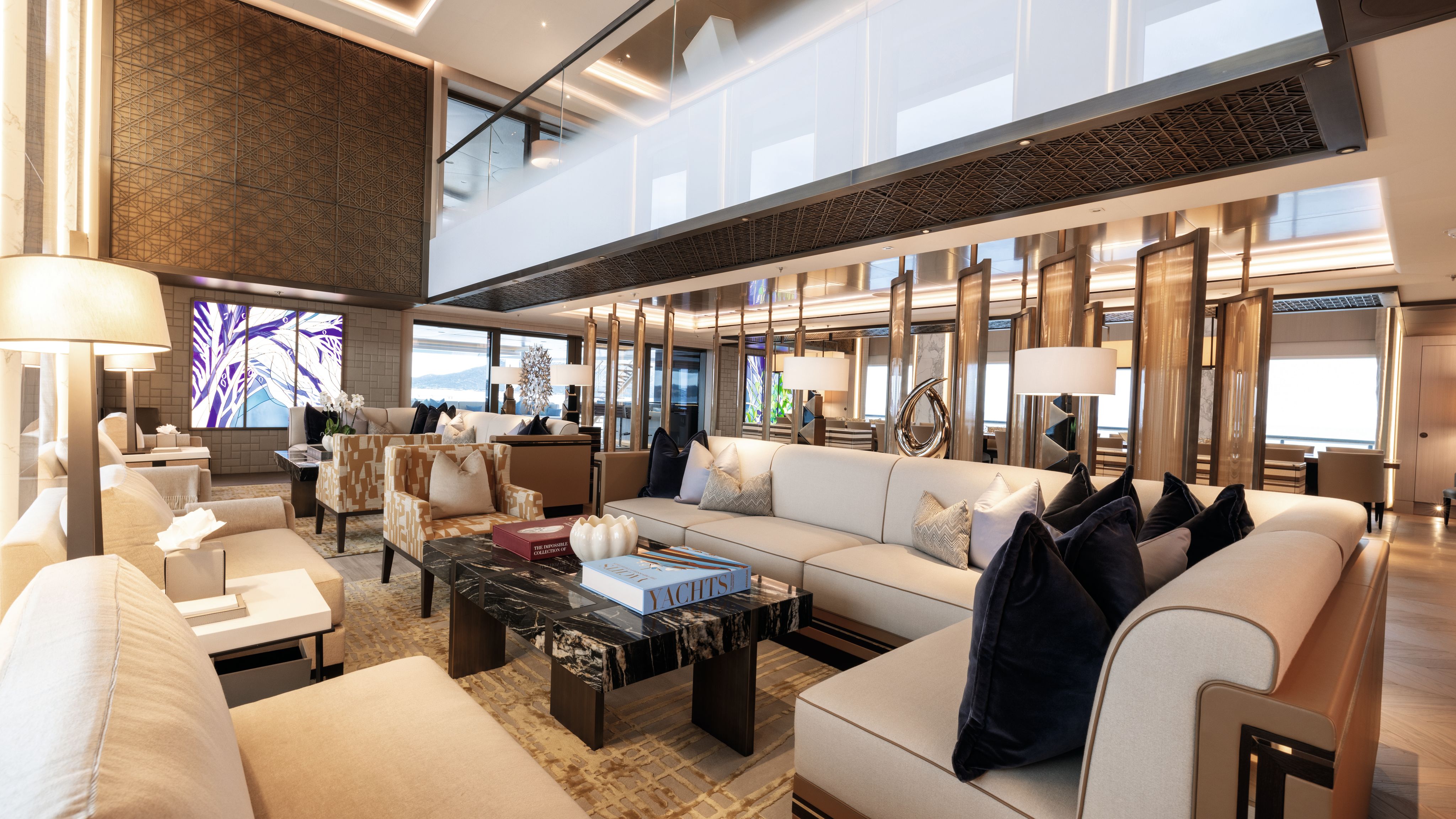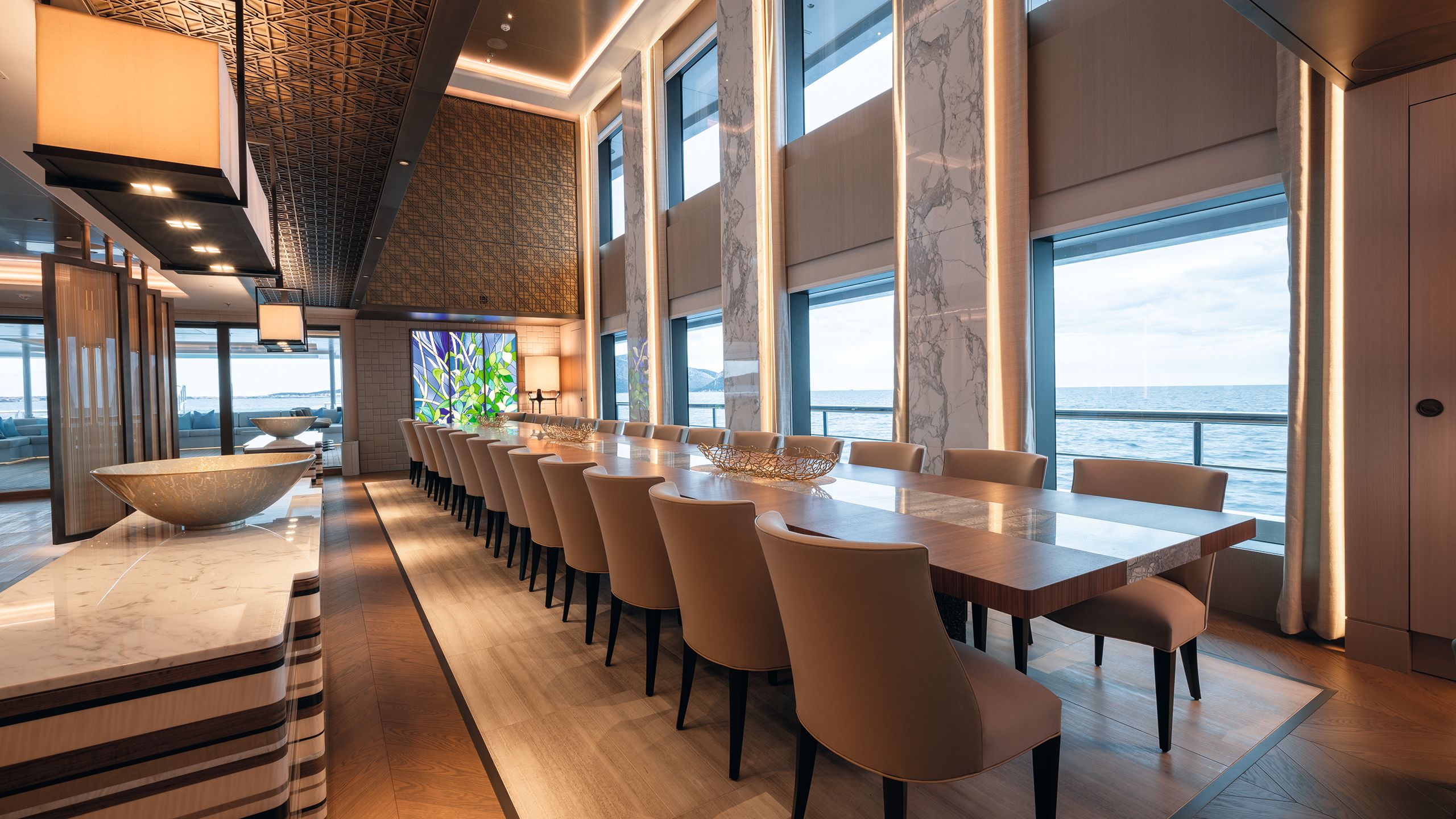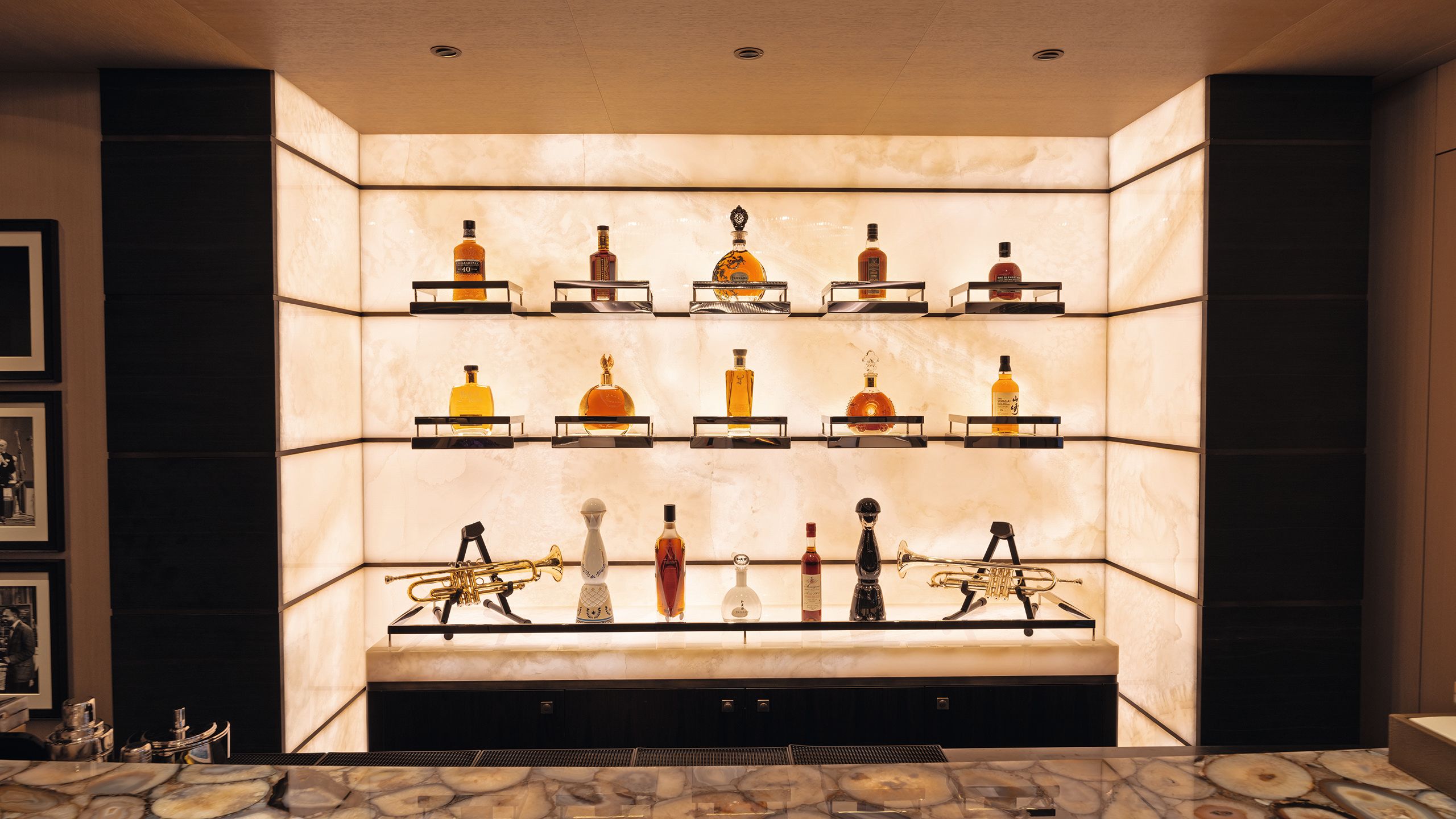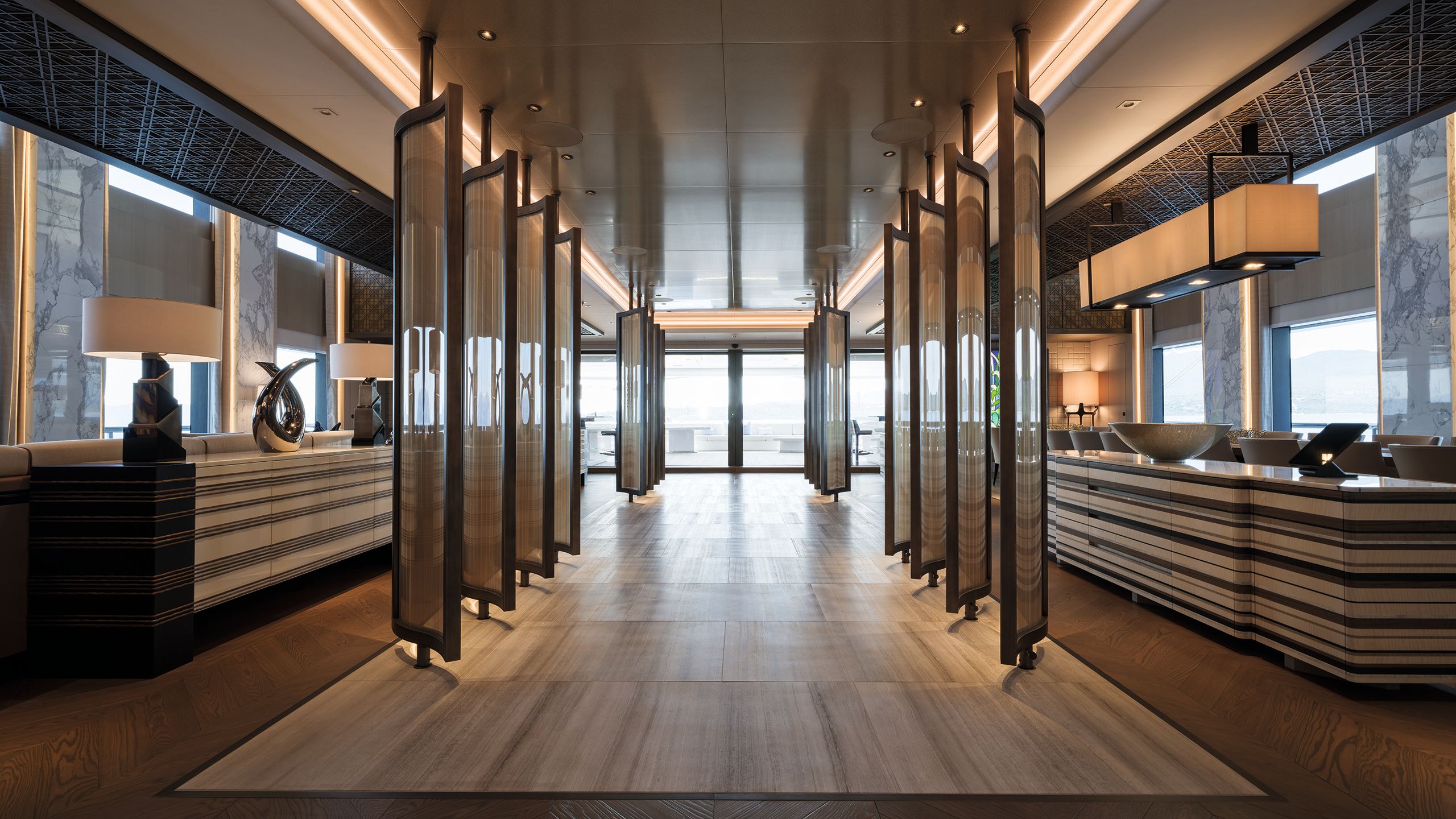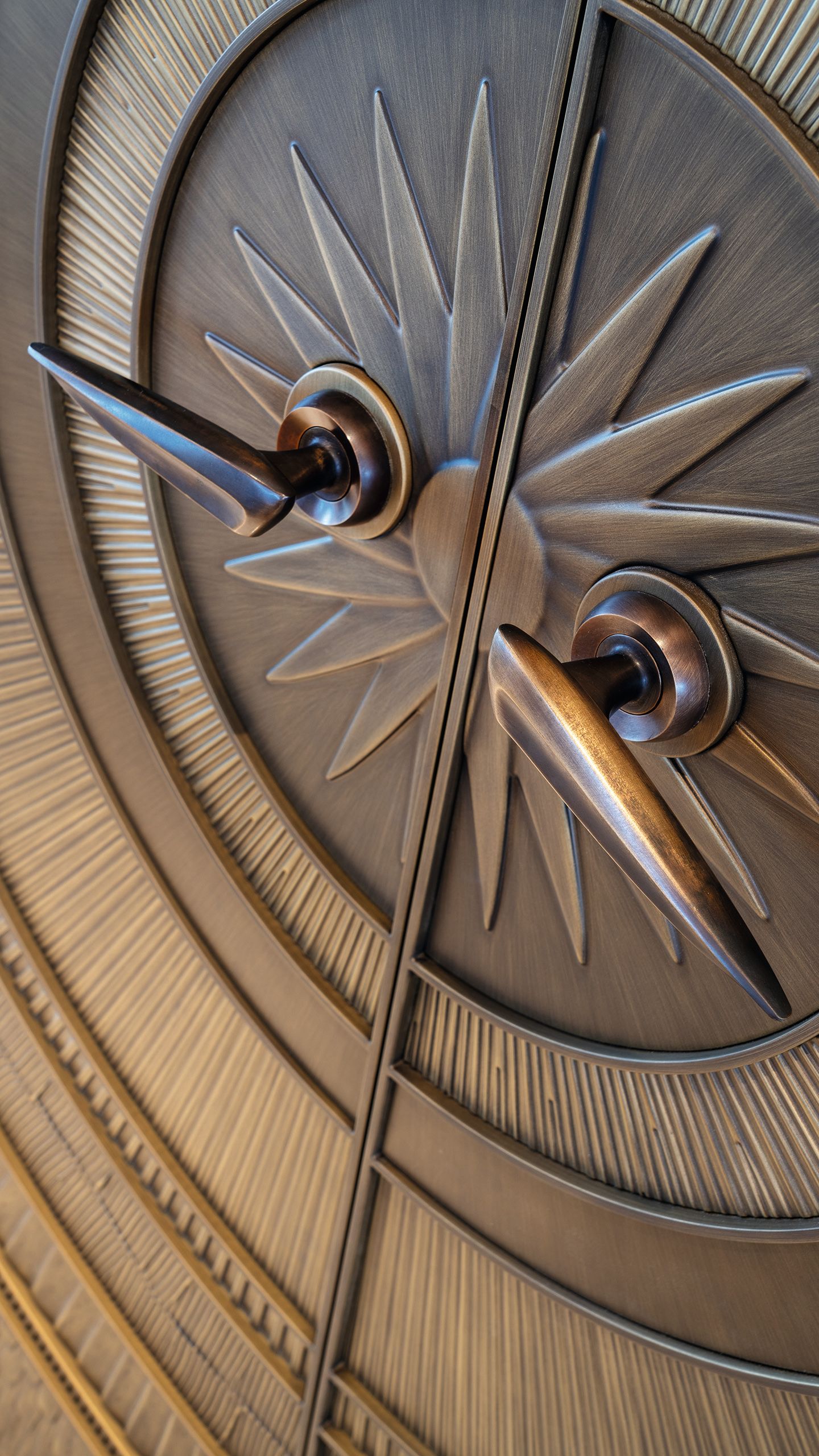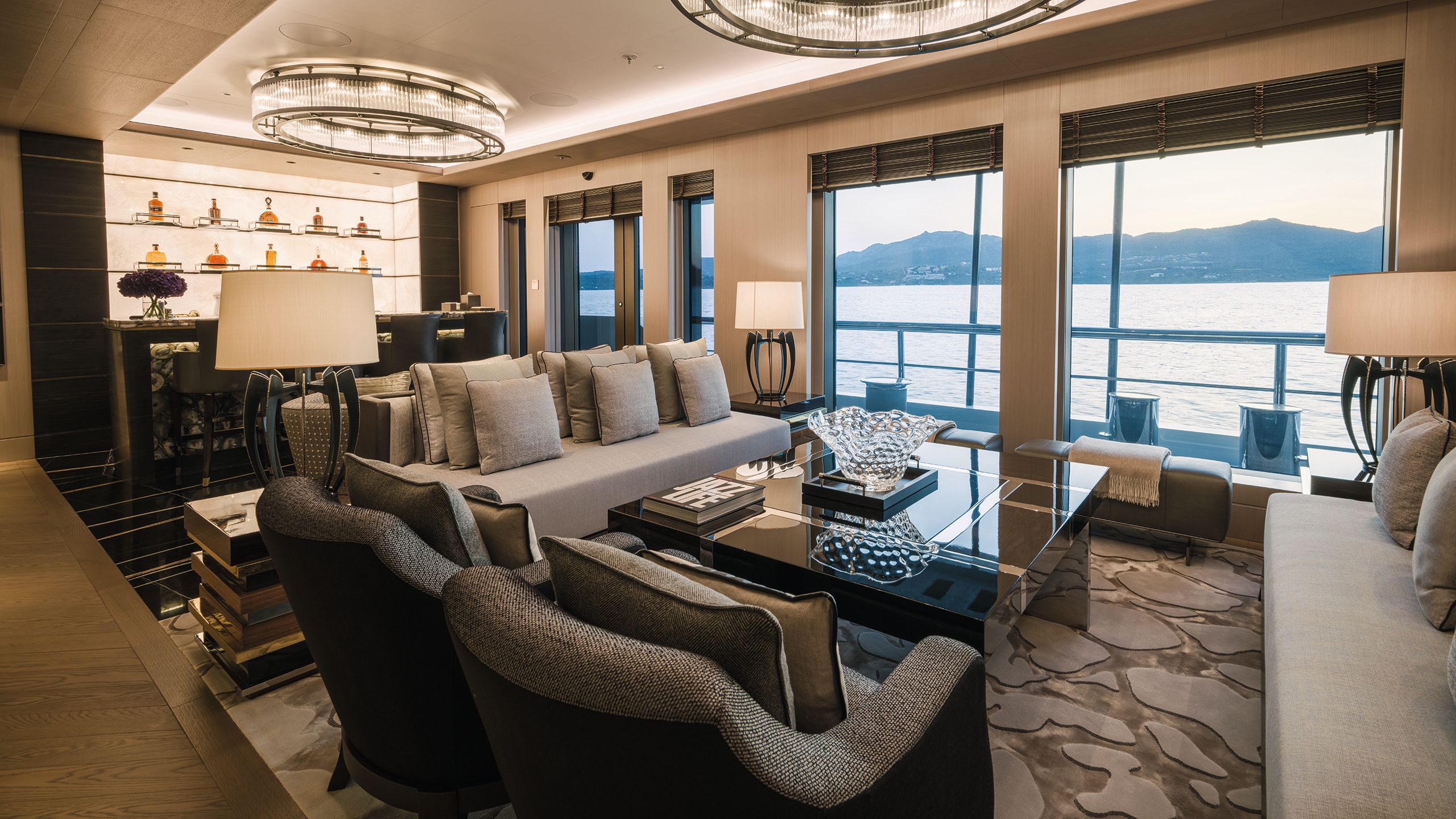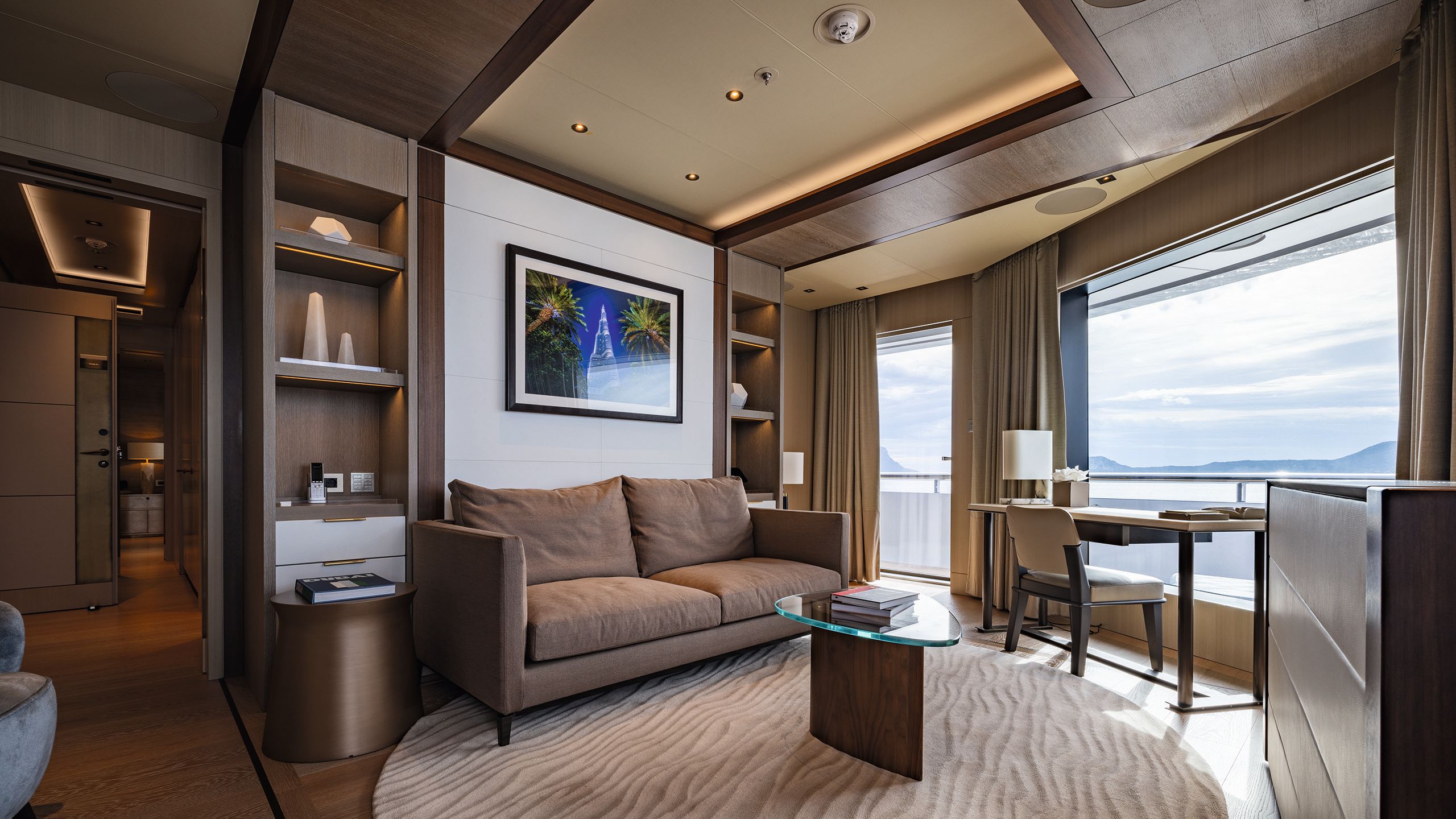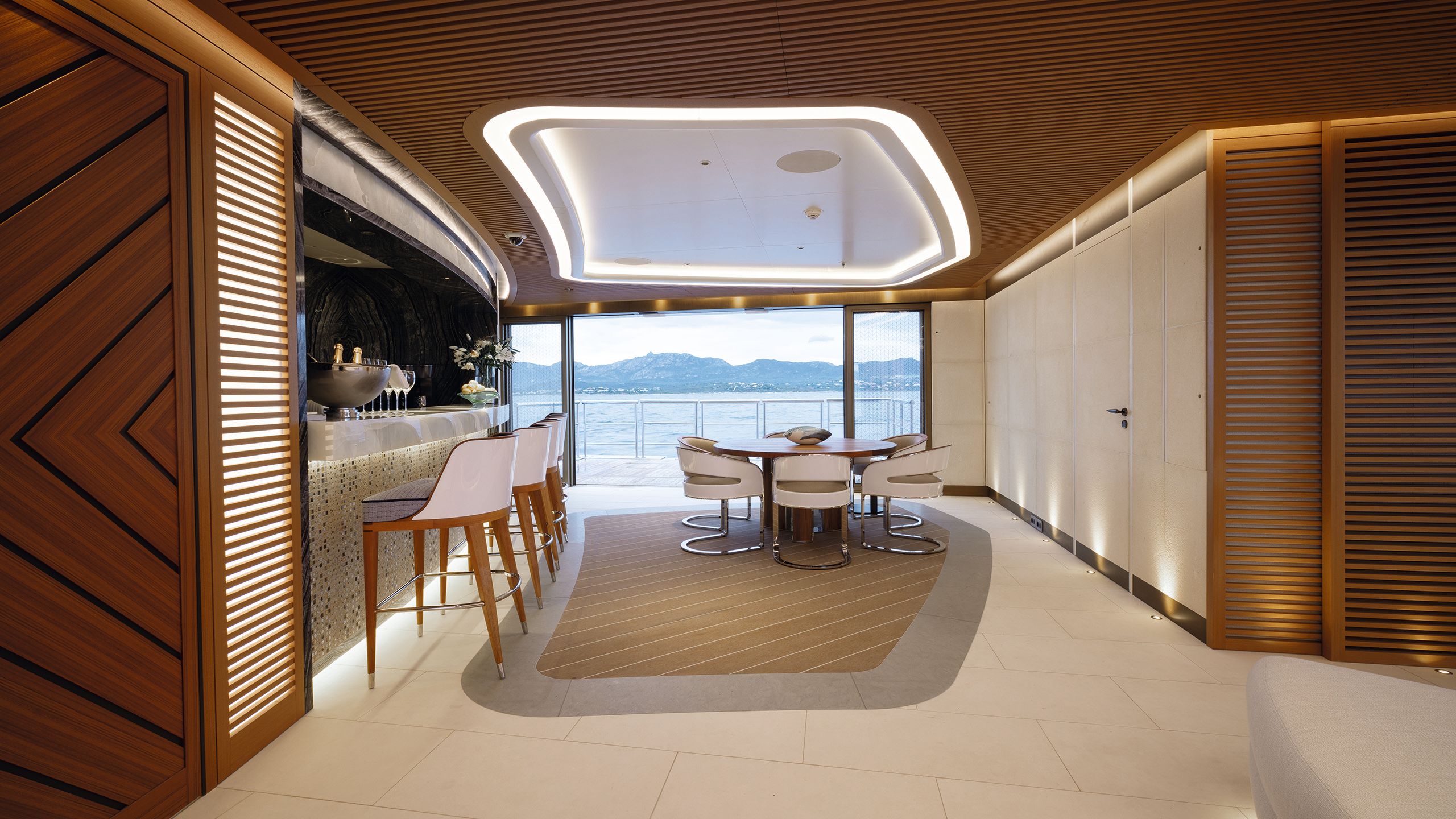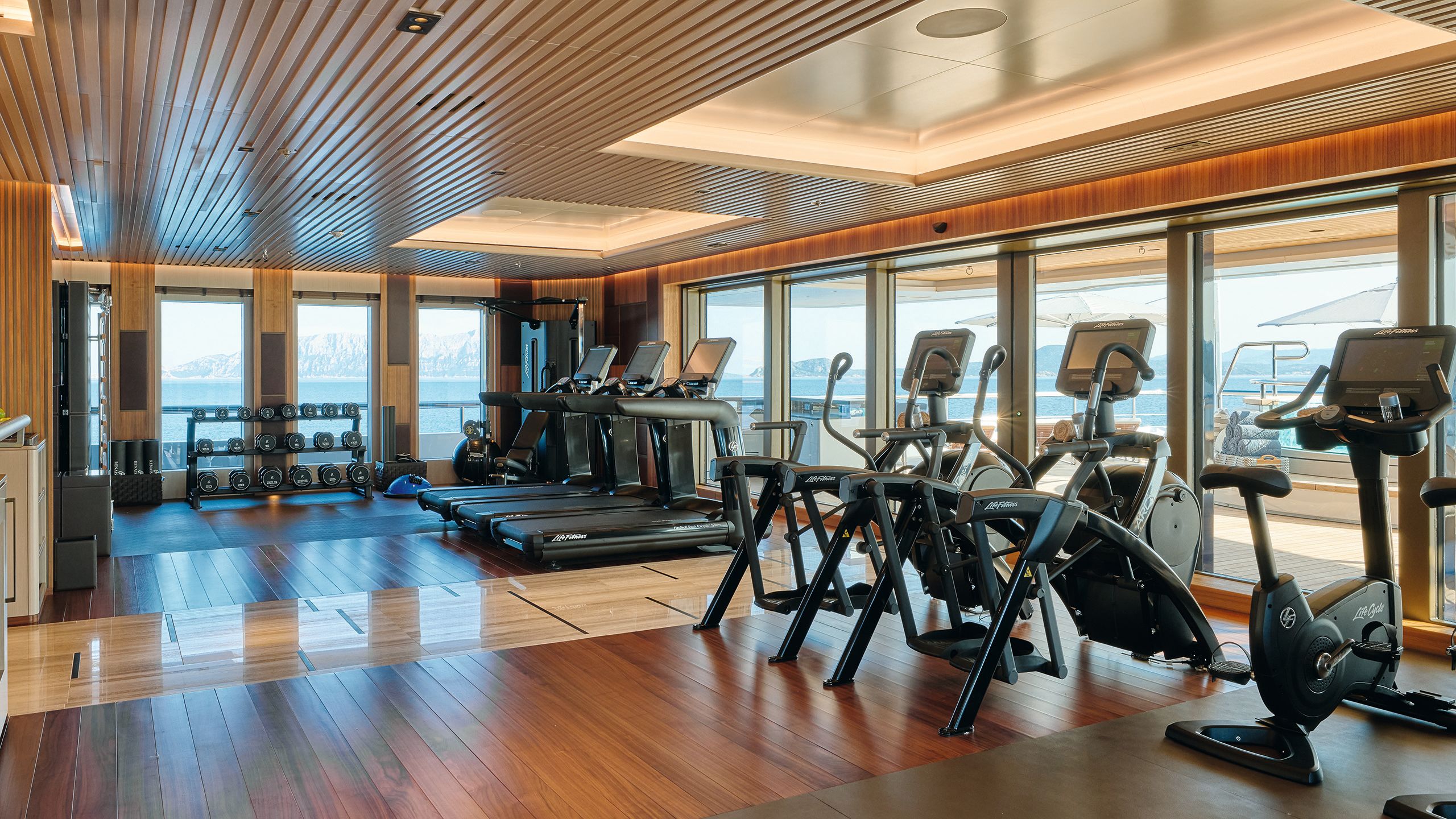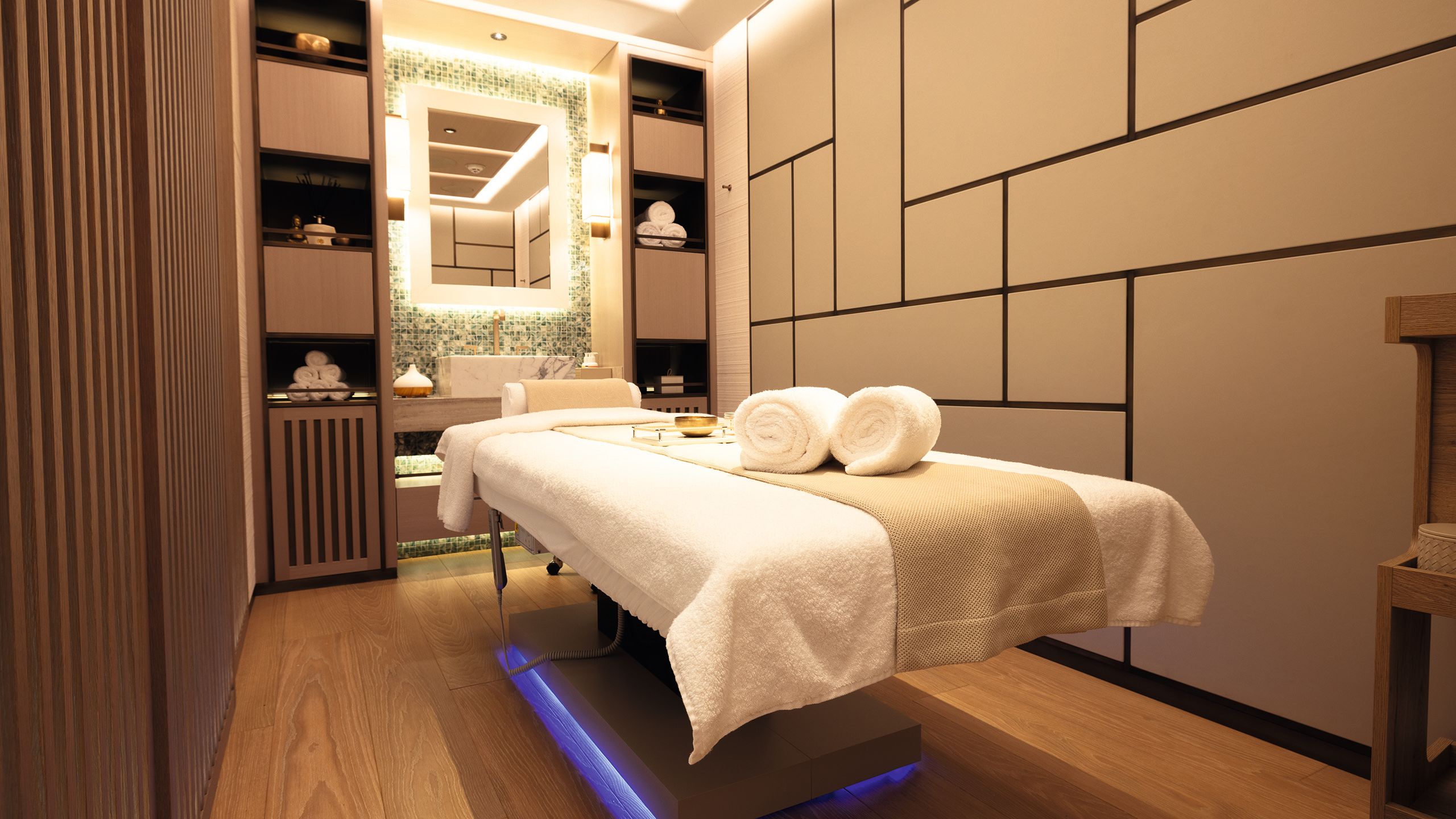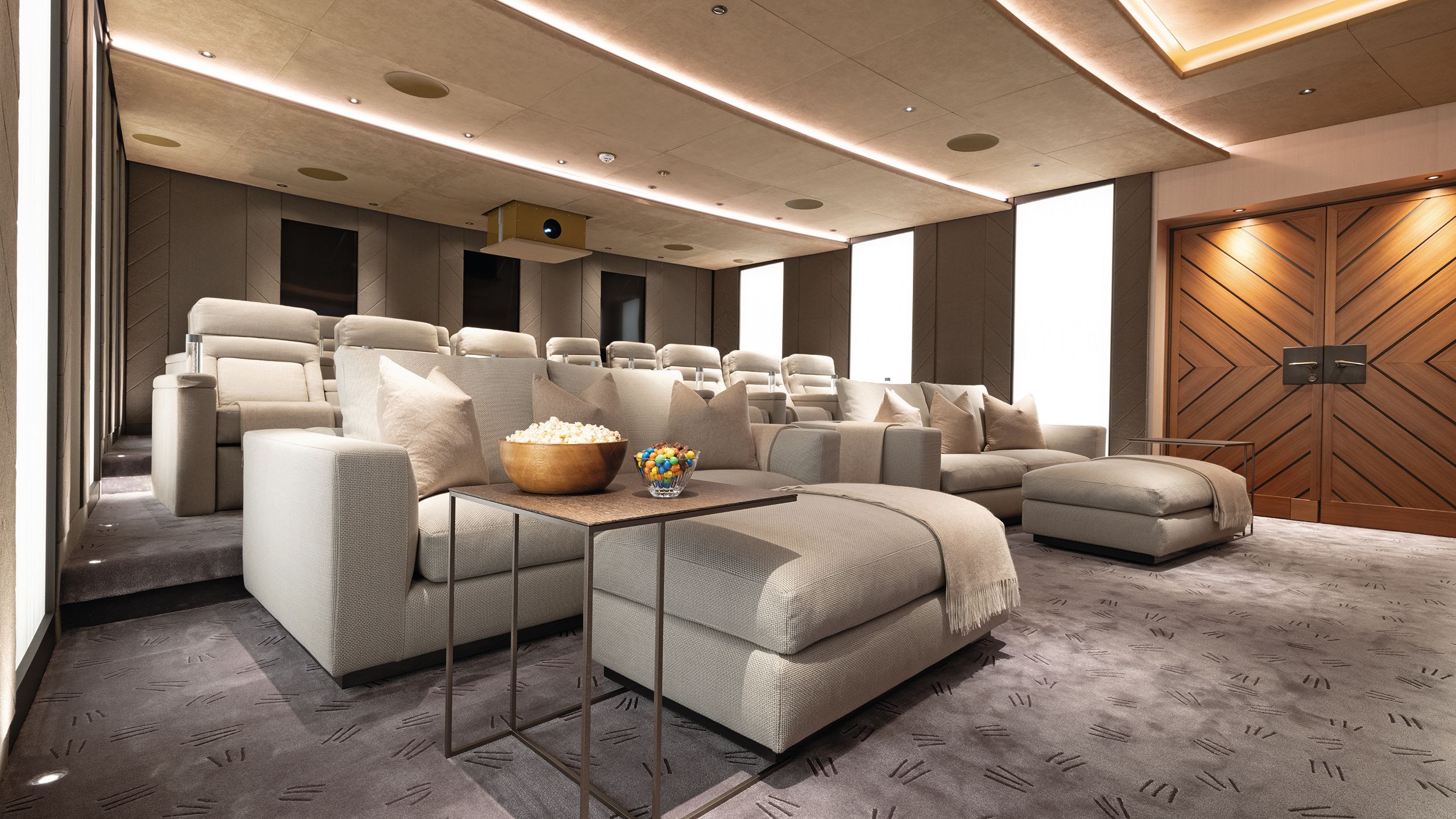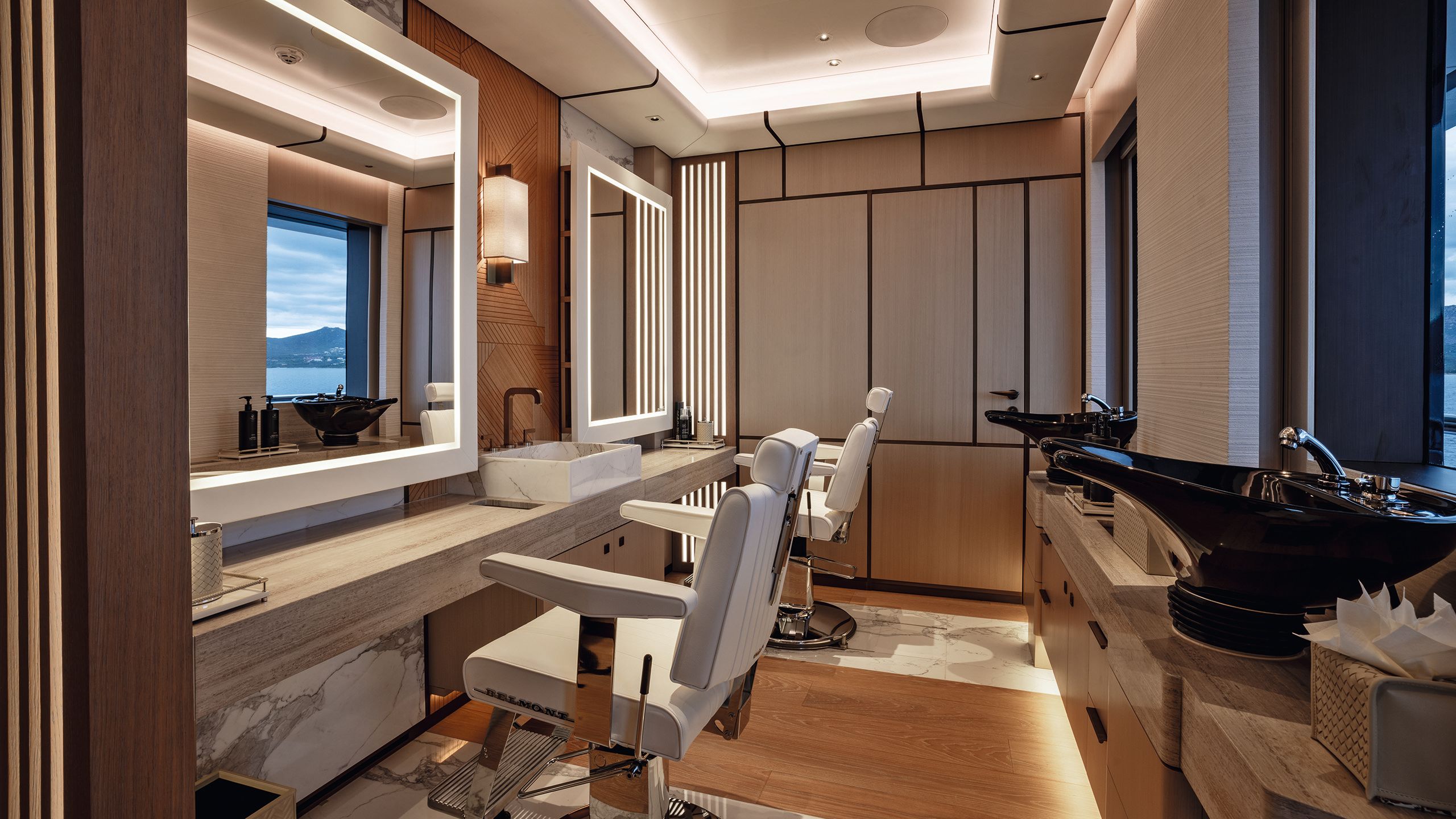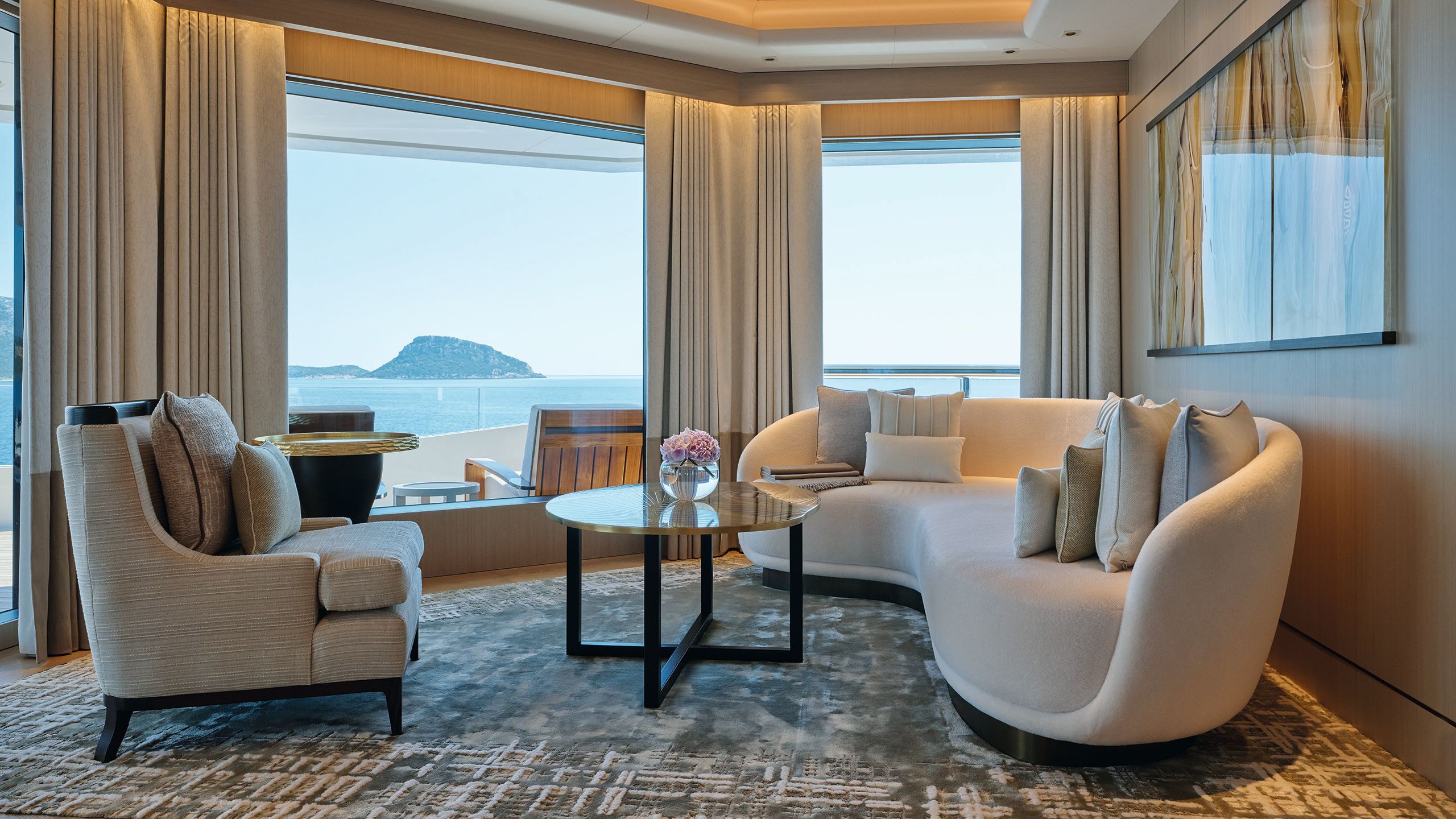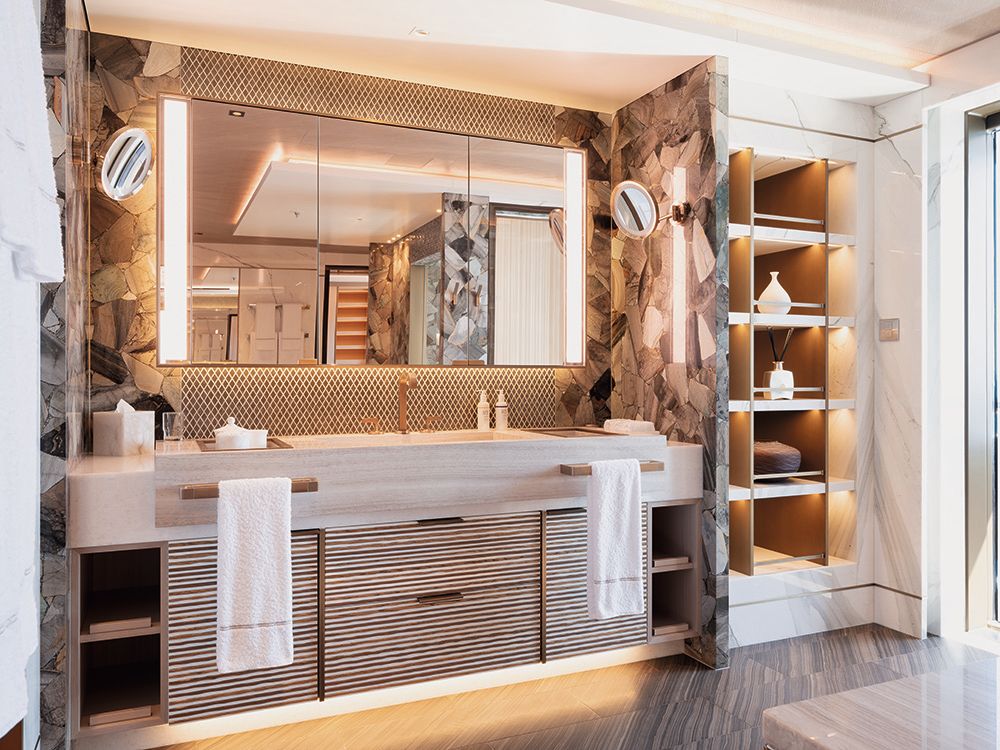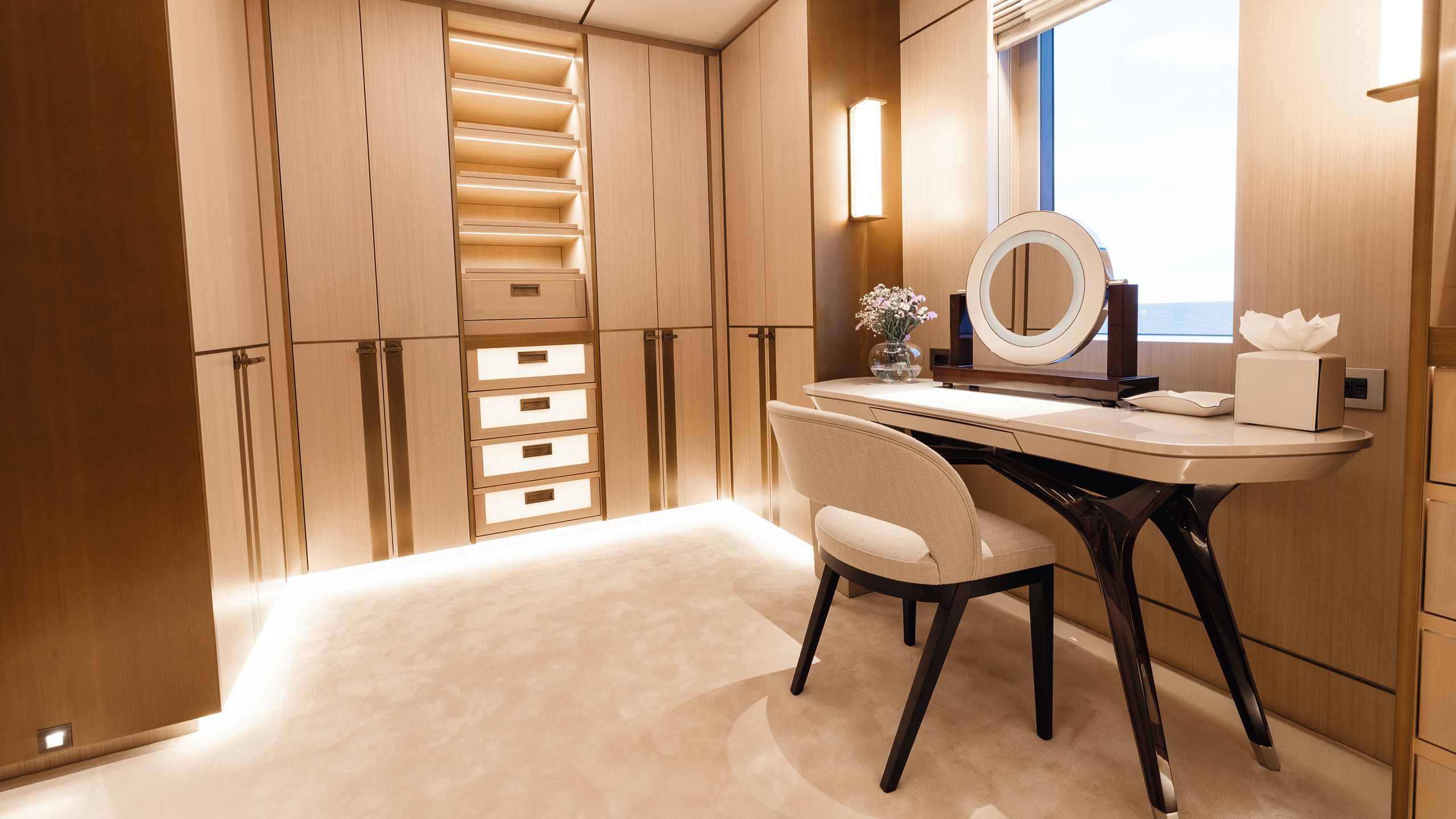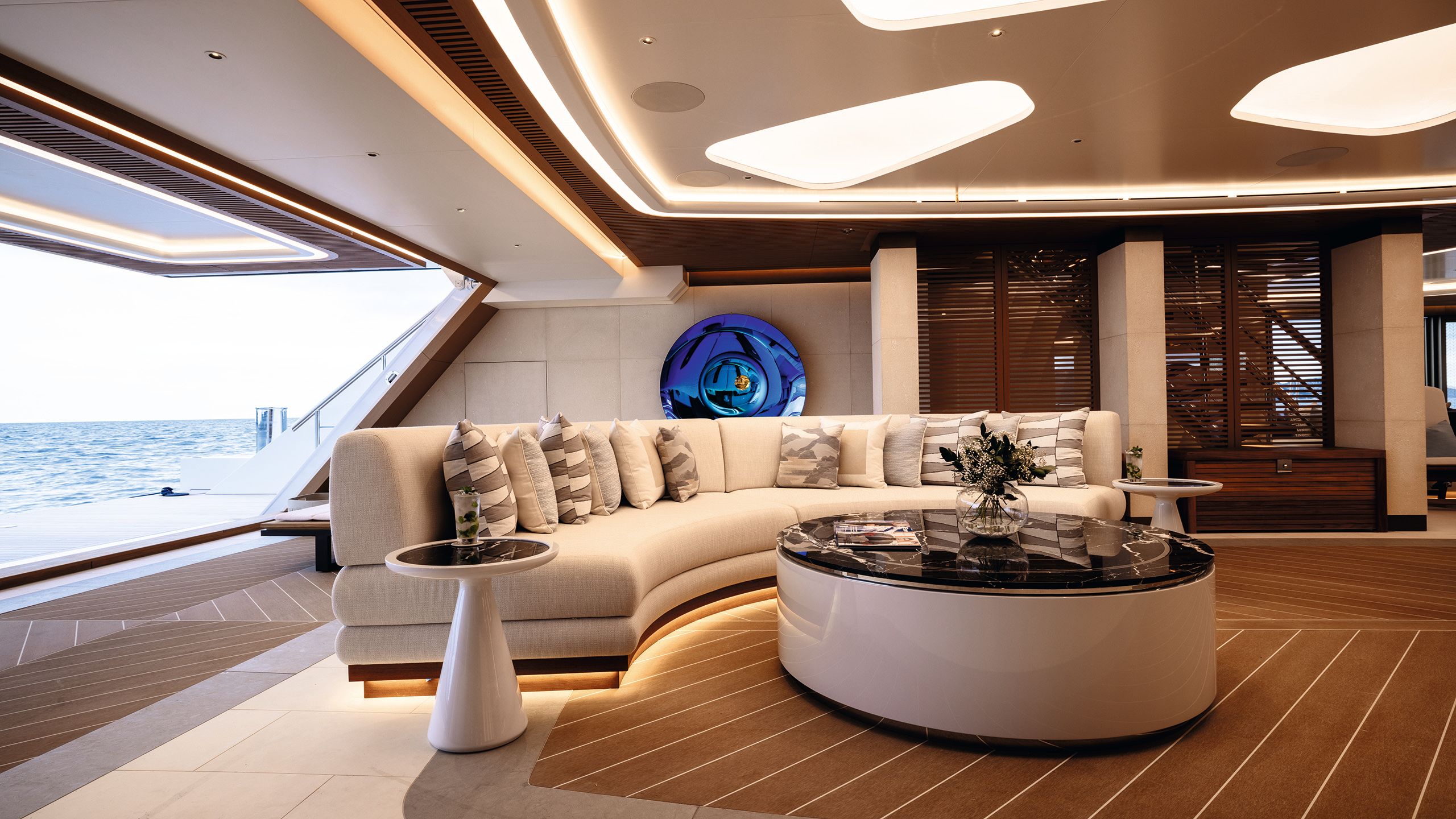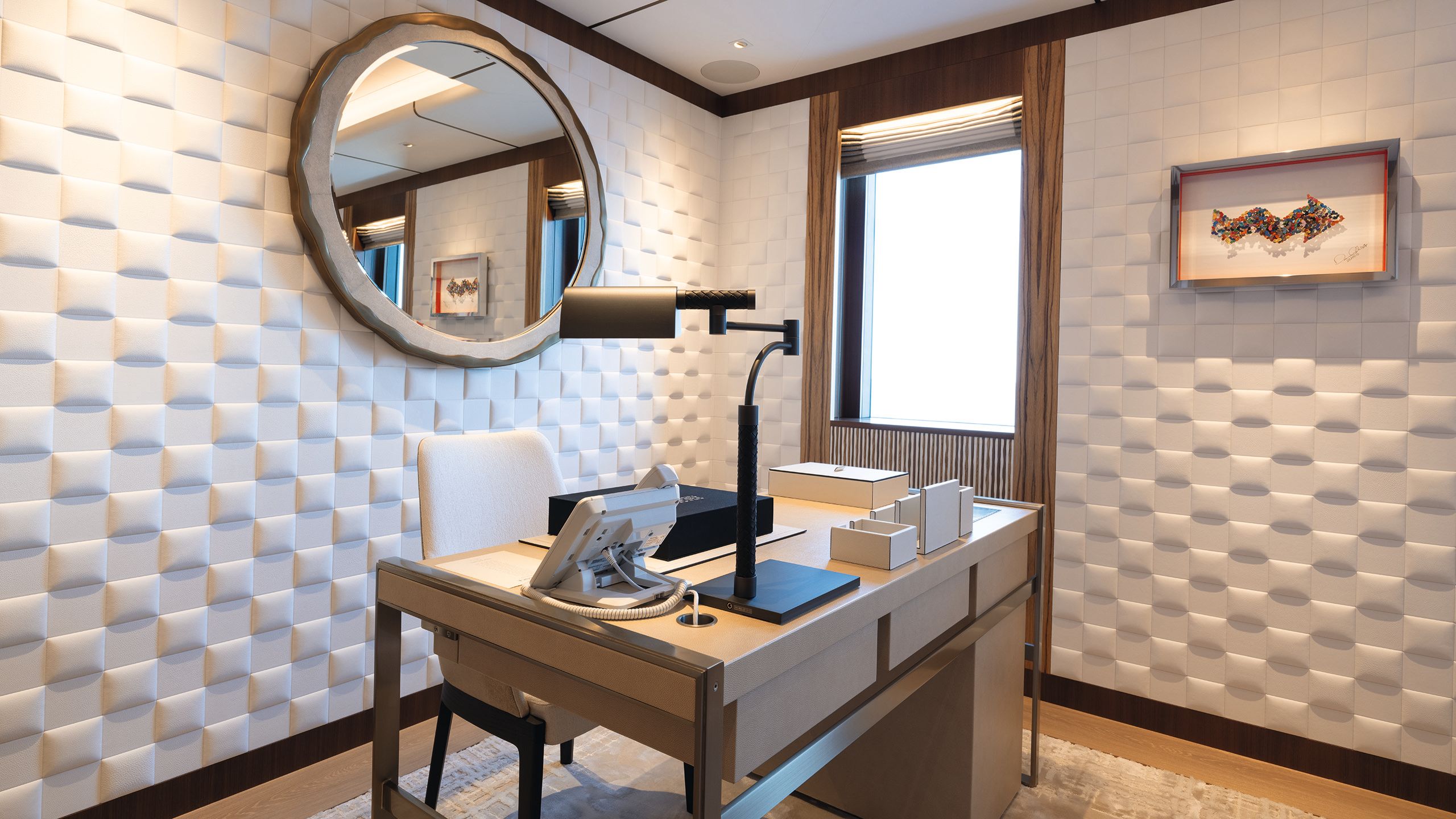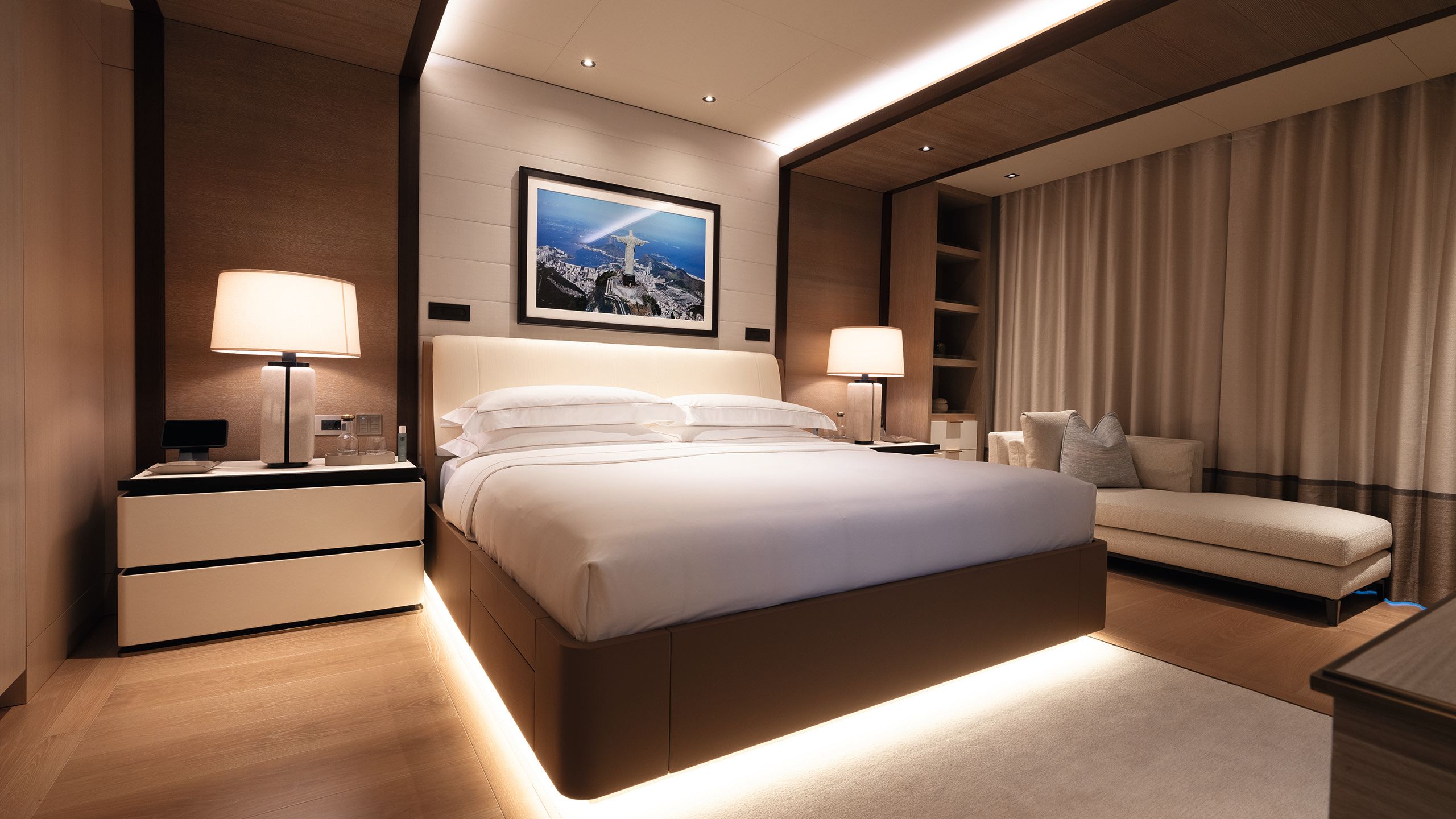BIRTH OF A
DREAM
Bringing Renaissance to reality
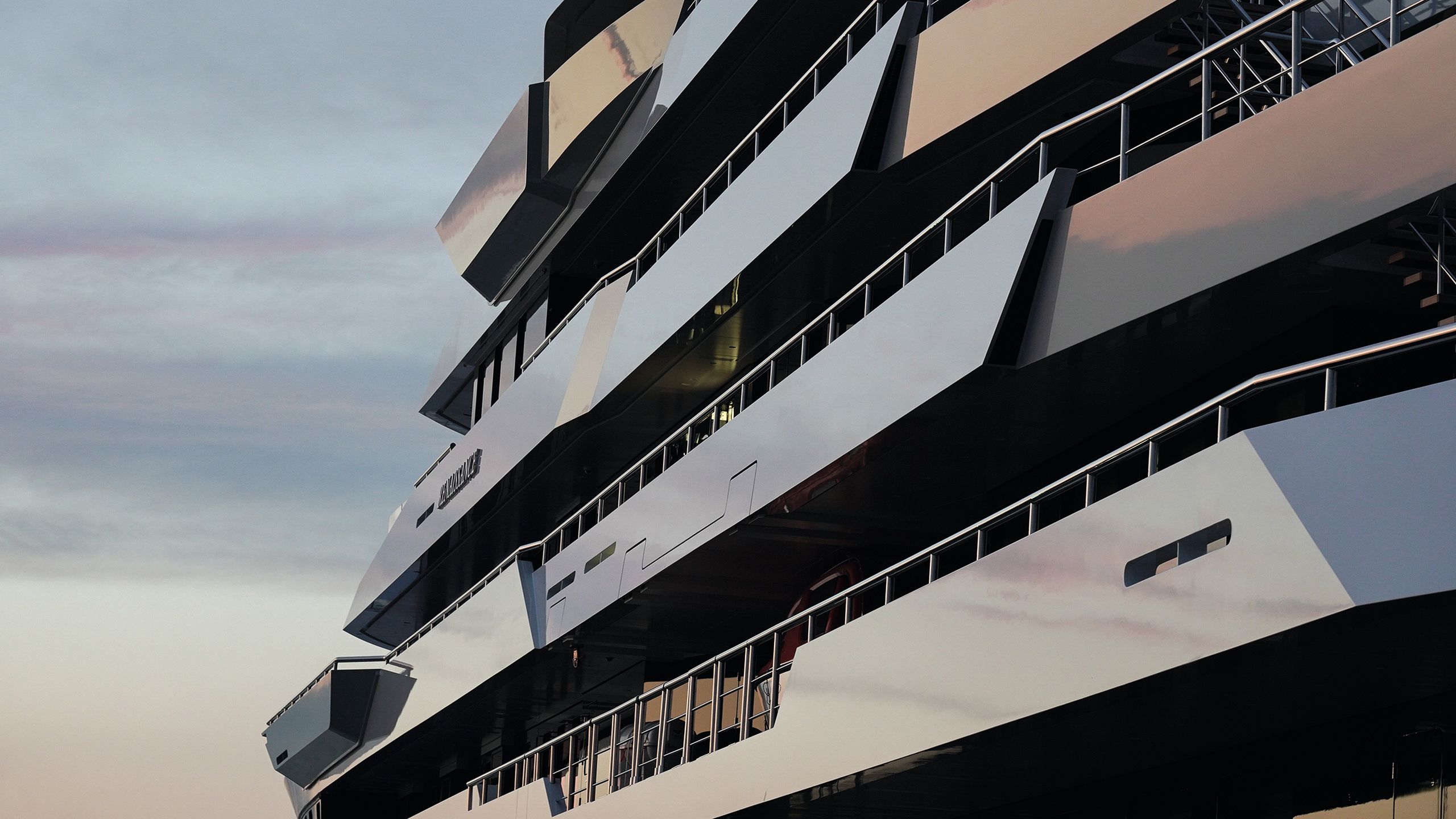
It took four decades of experience and imagination, and two generations of the Bannenberg design dynasty to bring 112-metre Freire yacht Renaissance to reality. Risa Merl steps on board to discover a yacht that’s both highly personal and made for charter
DAVID CHURCHILL
Nearly 40 years ago, legendary designer Jon Bannenberg penned a yacht that never left the drawing board. The would-be client went on to spend decades chartering in the Mediterranean and Caribbean, slowly refining a long checklist of everything they would want in their future yacht.
When it was finally time to build it, and with Bannenberg no longer with us, they turned to none other than Jon’s son at Bannenberg & Rowell Design. Forged by 35 years of charter experience, the 112-metre Freire-built Renaissance was born. Incredibly voluminous with an imaginative layout and clever features, Renaissance is not only one owner’s long-awaited dream boat, but a yacht that will have wide appeal on the charter market too.
COURTESY BURGESSRenaissance was built to Passenger Yacht Code and, as such, can take up to 36 guests on charter
COURTESY BURGESSRenaissance was built to Passenger Yacht Code and, as such, can take up to 36 guests on charter
“Dickie Bannenberg’s father, Jon, had designed a yacht for me way back in 1987 that never got built,” confirms the owner of Renaissance. “About 10 years ago, I hooked up with Dickie, and while my wife and I interviewed other yacht designers, Dickie and Simon [Rowell] best captured our thinking and converted it into a reality. Being able to work with Jon’s son was simply serendipitous.”
Bannenberg & Rowell have designed for children of Jon’s clients – including two yachts and two properties ashore – but this was a different kind of a project.
“It certainly was a full-circle moment,” says Dickie Bannenberg, company leader at Bannenberg & Rowell Design. “In fact, the client still has Jon’s original profile drawing of the rather more compact 42-metre that he designed for him.”
COURTESY BURGESSMeasured by volume, Renaissance is the 29th largest yacht afloat today
COURTESY BURGESSMeasured by volume, Renaissance is the 29th largest yacht afloat today
The through-line on this project stops at the Bannenberg name. Renaissance stands on her own, and indeed stands out among most yachts on the water today thanks to her immense proportions. “The volume of the yacht hits you right away,” says the owner.
“We had a long list of non-negotiables: a large gym, lots of cabins, high ceilings, lots of places to eat, a very large beach club...”
With a gross tonnage of 7,200GT, she is the 29th-largest yacht ranked by volume out of all yachts currently delivered. Yet despite being a behemoth of a vessel, Renaissance presents a streamlined and elegant profile. She also manages to be roomy without feeling cavernous and puts a priority on privacy while offering accommodation for a host of guests.
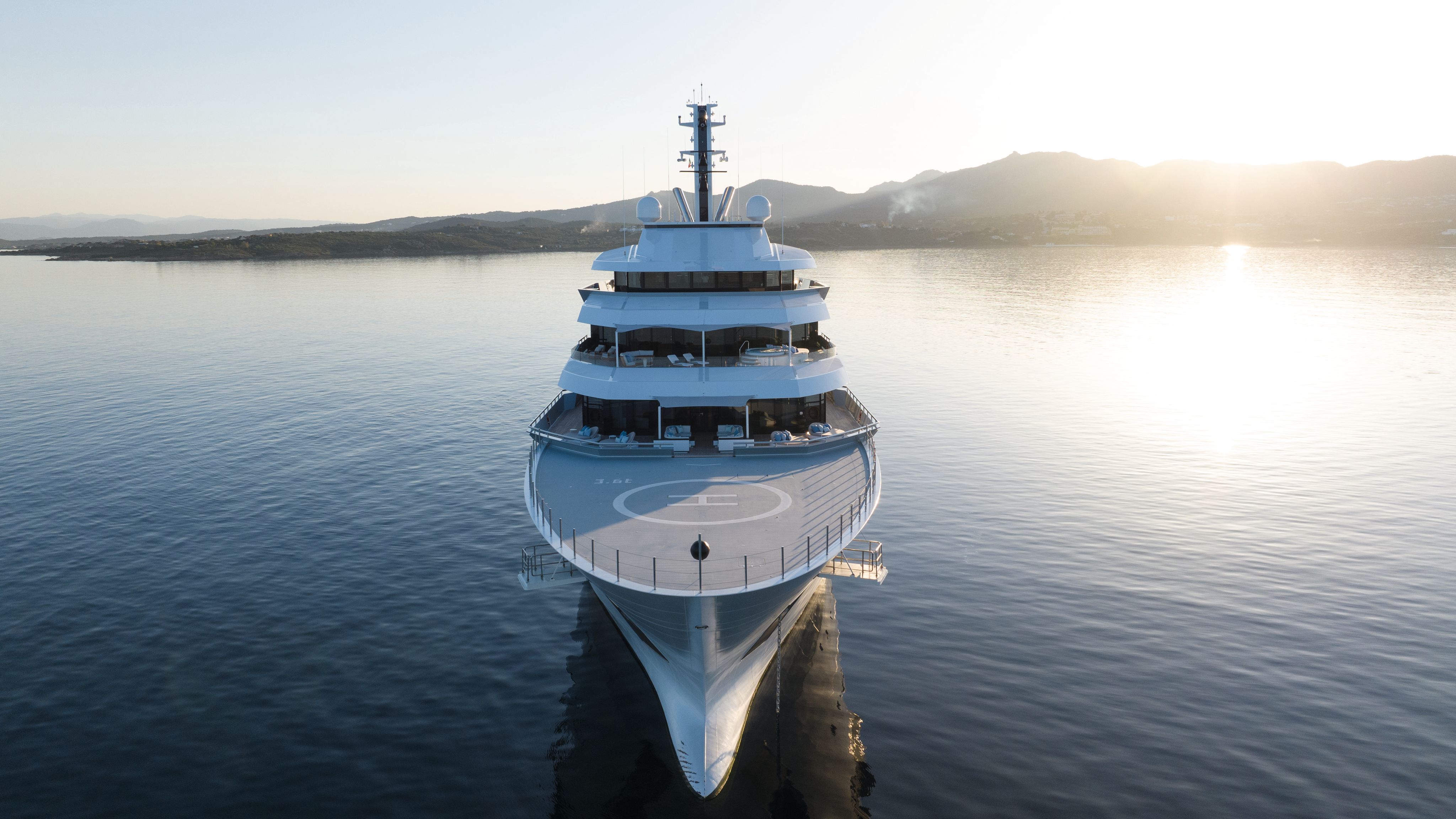
The aim was: “To design and build a 36-passenger, fully certified yacht for the charter market as well as for owner use,” says Andy North, the independent build project manager for Renaissance.
“The client was particularly interested in the facilities on board and, being themselves well-experienced charterers, gave considerable input into the equipment, from the gym and tenders and toys through to the interior and artwork.”
The owner’s brief was informed by how they’d use the yacht when on board along with what charterers might appreciate. The owner’s day starts with the gym, then it’s off to his office, which is adjacent to a fully outfitted business centre that guests or personal assistants can use, before unwinding with reading, sunning and watersports.
“We had a long list of non-negotiables,” says the owner. “A large gym, lots of cabins, high ceilings, lots of places to eat, a very large beach club, lots of entertainment spaces, an outdoor commercial pizza oven, waterproof wristbands that open the cabin doors and have a call button for service, indoor and outdoor cinemas, an ice-classed hull, a business centre, big spa and a private owner’s deck for me and my wife.”
COURTESY BURGESS
COURTESY BURGESS
COURTESY BURGESS
COURTESY BURGESS
COURTESY BURGESS
COURTESY BURGESS
The foredeck lounge overlooks the helipad (top right); guests have a plethora of outdoor spaces to soak up the sun and sea views (bottom and top left)
He was also keen to fix challenges experienced on previous yachts, says the owner’s rep, Damian Martin. “The owner is tall, and I think felt on previous charters that more headroom would be appreciated. You certainly won’t feel cramped anywhere on board.”
COURTESY BURGESS
COURTESY BURGESS
In early 2017, work began to flesh out and develop the design, taking this sizable wish list into consideration. The owner wanted to ensure there was a thorough description of what he wished to achieve before going out to shipyards for tendering, and he was actively involved in the development of the styling, layout and interior design.
“By the time the build started, the clients knew every inch of the layout by heart and could certainly judge the outcome against the design expectations,” says North.
COURTESY BURGESS
COURTESY BURGESS
Built to Passenger Yacht Code and carrying a Passenger Ship Safety Certificate, the full-displacement, ice-classed Renaissance was launched in 2023 by Spanish shipyard Freire, which is known for building complex commercial vessels.
It’s the yard’s second superyacht since delivering 74-metre Naia in 2011. Naval architecture comes from Norwegian ship engineering company Marin Teknikk, which designed the Kleven-built explorer yachts Multiverse and Andromeda.
Renaissance reaps the benefits of a commercial build when it comes to seaworthiness and safety, yet her rugged bones are draped in a stylish superyacht exterior, so there’s no mistaking her for an expedition yacht.
COURTESY BURGESS
COURTESY BURGESS
“We studied carefully how the layout would work: large ‘wow’ areas should be balanced by cosier and more finely detailed areas”
“If one looks at the pure volume on the Marin Teknikk engineering base, it’s an imposing package,” says Simon Rowell, creative director of Bannenberg & Rowell Design, who used overlapping planes on the superstructure and a simple homogeny of angles to fine-tune proportions.
Surfaces of the superstructure were broken up with a subtle change in colour from white to grey, the lowlights working to balance things visually, as do the lighter-toned deck canopy overhangs.
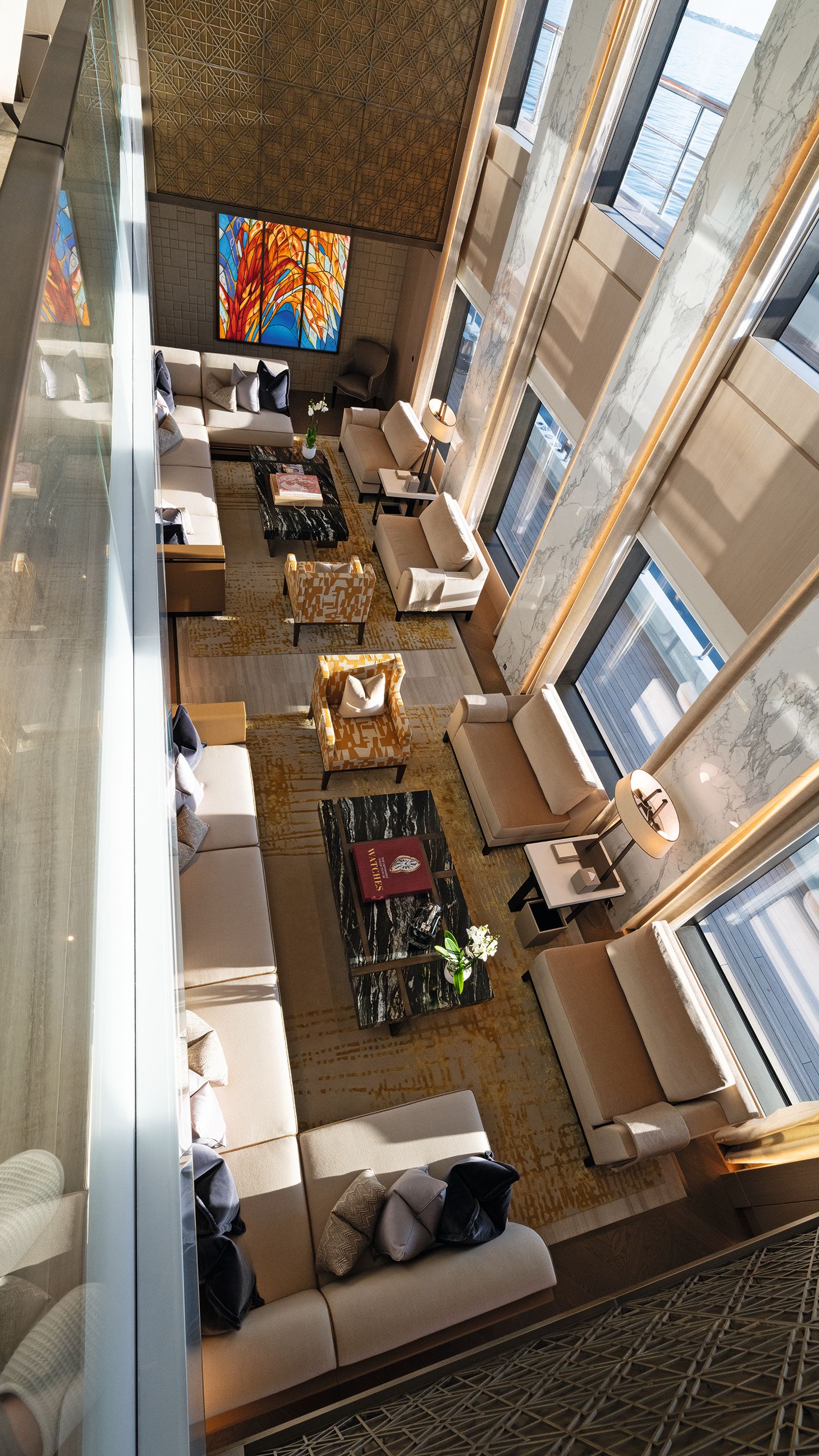
COURTESY BURGESSThe main saloon’s dining area – seating up to 30 – and lounge area enjoy the drama of two storeys of windows
COURTESY BURGESSThe main saloon’s dining area – seating up to 30 – and lounge area enjoy the drama of two storeys of windows
Renaissance’s silhouette is fairly symmetrical in profile, and the graphic design elements work well to suggest a forward stance.
“It lends purpose without menace,” says Rowell. “The addition of an angled ‘corner’ to aft deck bulwarks helps to visually enhance this stance, while easing the potentially overwhelming mass when approaching the transom by tender.”
The designers performed a careful balancing act inside as well. From the get-go, there was a focus on optimising the space.
COURTESY BURGESSThe main saloon’s dining area – seating up to 30 – and lounge area enjoy the drama of two storeys of windows
COURTESY BURGESSThe main saloon’s dining area – seating up to 30 – and lounge area enjoy the drama of two storeys of windows
“We studied carefully how the layout would work: large ‘wow’ areas should be balanced with cosier and more finely detailed areas,” says Rowell.
Many larger yachts have a too-vast and often-under-used main saloon, but Renaissance avoids this. Along the centreline of the double height space, a mezzanine level hangs down lower, carving the saloon into two distinct living areas. To port is a long dining table (which can seat up to 30 guests or be reduced for a more intimate gathering) and to starboard a lounge.
Renaissance’s silhouette is fairly symmetrical in profile, and the graphic design elements work well to suggest a forward stance.
“It lends purpose without menace,” says Rowell. “The addition of an angled ‘corner’ to aft deck bulwarks helps to visually enhance this stance, while easing the potentially overwhelming mass when approaching the transom by tender.”
The designers performed a careful balancing act inside as well. From the get-go, there was a focus on optimising the space.
“We studied carefully how the layout would work: large ‘wow’ areas should be balanced with cosier and more finely detailed areas,” says Rowell.
Many larger yachts have a too-vast and often-under-used main saloon, but Renaissance avoids this. Along the centreline of the double height space, a mezzanine level hangs down lower, carving the saloon into two distinct living areas. To port is a long dining table (which can seat up to 30 guests or be reduced for a more intimate gathering) and to starboard a lounge.
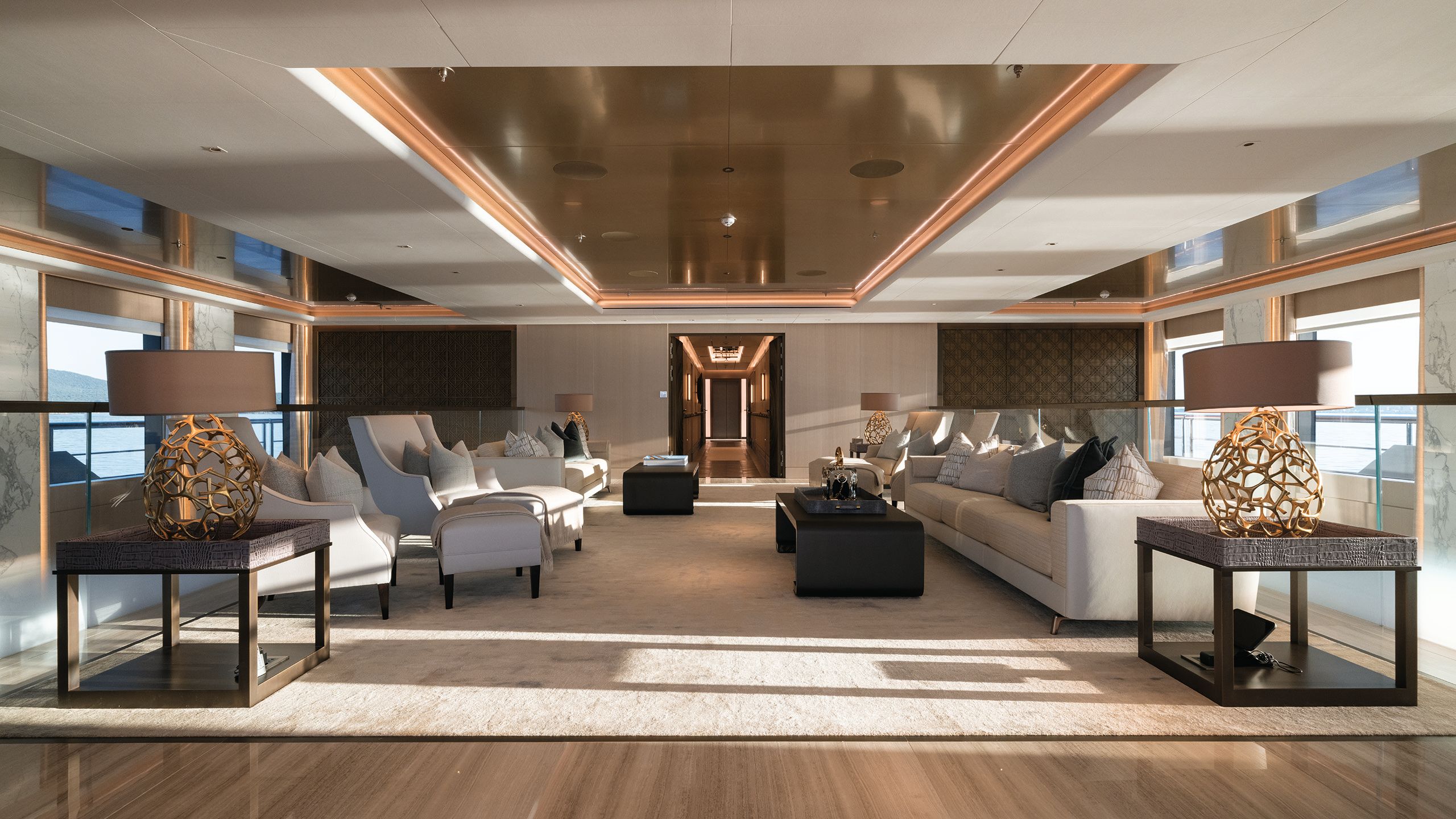
COURTESY BURGESSA mezzanine lounge hangs between the main deck’s dining and lounging areas
COURTESY BURGESSA mezzanine lounge hangs between the main deck’s dining and lounging areas
Rowell had been developing this twin atria concept for a while. A smaller version was tried out when planning the 87-metre Lürssen yacht Avantage, but the deck apertures reduced interior living space, so it didn’t go ahead.
“But on a larger yacht, it really worked,” he says. “The drama of a double-height outboard interior elevation is much more impressive to me than a more typical internal galleried atrium.” The bridge-like mezzanine level above holds a “floating” lounge that takes in the sight lines from three sides of the vessel.
The bridge-like mezzanine level holds a “floating” lounge that takes in the sight lines from three sides of the vessel
Also in the saloon, a walkway runs between two rows of vertical, articulating s-shaped screens used as room dividers. The glass screens are embedded with a Sophie Mallebranche bronze-coloured mesh and framed in metal.
COURTESY BURGESS
COURTESY BURGESS
COURTESY BURGESS
COURTESY BURGESS
DAVID CHURCHILL
DAVID CHURCHILL
COURTESY BURGESS
COURTESY BURGESS
The owner personally chose the rare cognacs for the jazz bar on the main deck (top left and bottom); lounge areas are separated by glass screens with Sophie Mallebranche mesh that open and close depending on the level of privacy desired (top centre)
“The foiling screens allow the relationship between the three main deck zones – formal dining, main saloon and circulation route – to be changeable and flexible, while also retaining a glamorous central catwalk ‘first look’ experience,” says Rowell.
The screens can close to further separate the dining room and lounge area and provide privacy, or open at an angle to draw the eyes forward towards an elaborate bronze door – another just like it opens onto the mezzanine balcony above.
The main deck and mezzanine lounge are indicative of the approach to have a variety of cosier spaces. One such lounge is the jazz bar, set just forward of the main saloon, which feels like stepping into a glamorous speakeasy adorned in backlit onyx.
“The owner personally selected rare cognacs for the bar and directed the arrangement of framed black-and-white photos of jazz masters on the walls,” says Rowell. The owner’s wife has a background in art and curated all of the artwork seen on board, including in the gallery nook at the foyer to the upper deck guest accommodation.
A study in earthy tones, the decor is interesting yet subtle enough to appeal to a wide range of guests
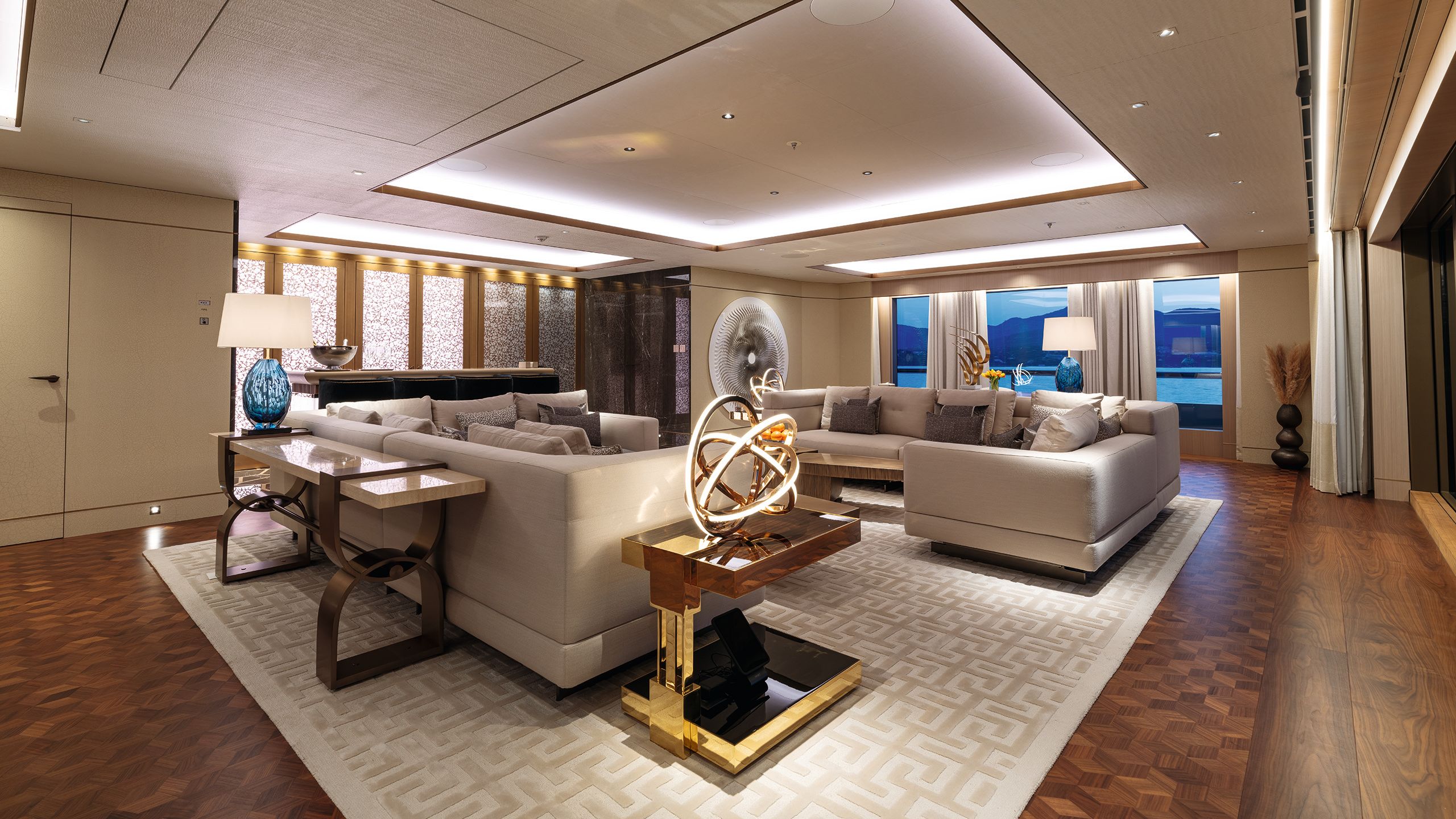
Bannenberg & Rowell reimagined the typical general arrangement by putting the bridge all the way on the top deck, in lieu of a more traditional sundeck.
This creates an exceptionally lofty viewpoint for the captain and crew, and ensures the owner’s and guests’ privacy as the bridge doesn’t look out directly over any living areas. An adjacent bridge lounge is outfitted with a large TV screen for itinerary briefings.
COURTESY BURGESS
COURTESY BURGESS
Other “dedicated” decks include the owner’s deck and spa deck. The owner’s cabin enjoys forwardfacing views and access to its own forward deck with spa tub.
“Usually, you’d find a TV rising up in front of the bed, but they opted against that and have their own private TV lounge,” says Captain Gordon Campbell, pointing to a snug set between the separate his-and-hers bathrooms.
A feather-filled glass table by David Gill found in the TV lounge is just one of the special pieces of furniture in the owner’s suite, along with the sideboard by Hoeller.
ON DEMAND
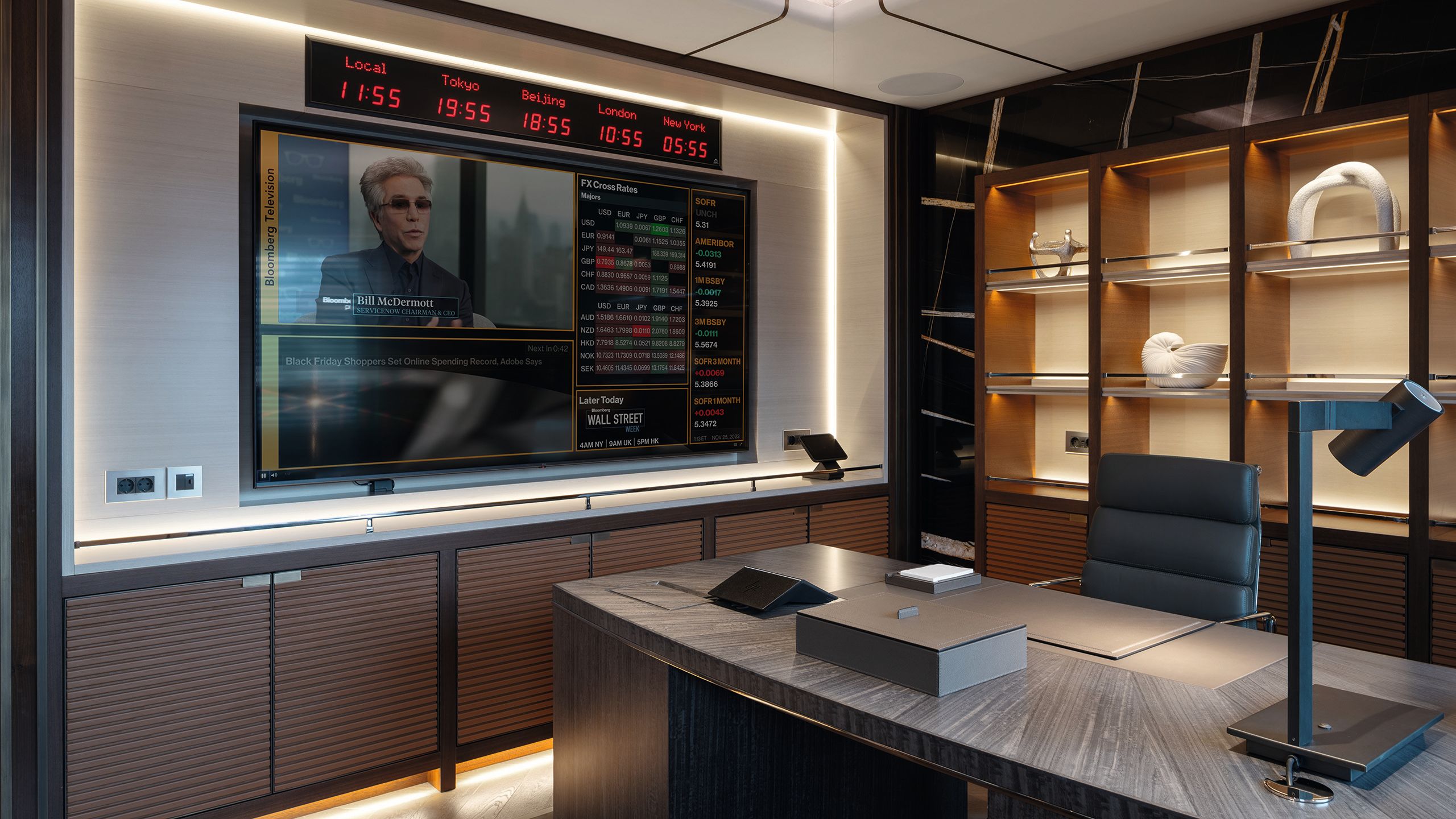
The owner of Renaissance wanted to ensure guests enjoyed privacy while still being well looked after by crew, without relying on cameras or having staff constantly popping up to check in on guests. The owner worked with Videoworks to create a new piece of technology and achieve this balance of privacy and attentiveness.
“It was the first time we developed this sort of customer-requested technology,” says Francesco Pierpaoli, CIO of Videoworks. “The owner’s objective was to have a way for guests to request assistance with a button on the bracelet that relays the position of the guest.”
Dubbed myTracking, a tracker token is embedded in a waterproof bracelet and uses geolocation via Bluetooth. When guests require assistance, crew are notified of their location and details.
Using various communication channels such as Telegram instant messages, onscreen notifications or UHF radio, the system seamlessly integrates into onboard operations.
“Bluetooth, unlike Wi-Fi, is a low-consumption technology,” says Pierpaoli. “This is the point as the battery lasts for years. It’s not necessary to recharge the bracelets or change the batteries, so they can last for several seasons. We have also added further functionality into the bracelet, which guarantees access to rooms from the crew. This function will also probably substitute the use of badges.”
The owner of Renaissance wanted to ensure guests enjoyed privacy while still being well looked after by crew, without relying on cameras or having staff constantly popping up to check in on guests.
The owner worked with Videoworks to create a new piece of technology and achieve this balance of privacy and attentiveness. “It was the first time we developed this sort of customer-requested technology,” says Francesco Pierpaoli, CIO of Videoworks.
“The owner’s objective was to have a way for guests to request assistance with a button on the bracelet that relays the position of the guest.”
Dubbed myTracking, a tracker token is embedded in a waterproof bracelet and uses geolocation via Bluetooth. When guests require assistance, crew are notified of their location and details.
Using various communication channels such as Telegram instant messages, onscreen notifications or UHF radio, the system seamlessly integrates into onboard operations. “Bluetooth, unlike Wi-Fi, is a low-consumption technology,” says Pierpaolo.
“This is the point as the battery lasts for years. It’s not necessary to recharge the bracelets or change the batteries, so they can last for several seasons. We have also added further functionality into the bracelet, which guarantees access to rooms from the crew. This function will also probably substitute the use of badges.”
While developed for Renaissance, this technological solution will now be added to Videoworks’ portfolio so other yachts can take advantage of this innovation in the future.
The owner is passionate about fitness, so a fully outfitted gym was a priority part of the spa deck. Carved limestone walls and recessed floor lighting in the spa entryway welcome guests into this realm of relaxation.
The owner’s brief for “the best spa” included having proper plunge pools (both hot and cold) along with a hammam, sauna, multiple treatment rooms and a hair and beauty salon.
COURTESY BURGESSA large beach club was one of the owner’s must-haves on board
COURTESY BURGESSA large beach club was one of the owner’s must-haves on board
Many of the amenities on board were chosen with charterers in mind, from the pizza oven and sushi bar on the aft main deck, to the party set-up on the aft bridge deck, which has the largest al fresco dining on board seating 20, a barbecue, DJ booth and speakers.
“It’s not that the owner is a big partier,” the captain says, “but we want charterers to be able to bring a DJ and fully enjoy.”
COURTESY BURGESS
COURTESY BURGESS
COURTESY BURGESS
COURTESY BURGESS
COURTESY BURGESS
COURTESY BURGESS
COURTESY BURGESS
COURTESY BURGESS
The spa is world-class, with a generous gym, hammam, sauna, hot and cold plunge pools, plus a beauty salon and massage rooms; the cinema can seat 19 (bottom left)
From the master to the main saloon, the interior is a study in earthy tones. The decor is interesting yet subtle enough to appeal to a wide range of guests. But in the guest cabins – which are themed after major cities and yachting locales from Rome to Miami and Monaco to Capri – further details are layered in to match the destination, whether it’s a vibrant throw pillow in Rio or a Grecian vase in Mykonos. The owner wanted guests to have equitable accommodation, and nearly all the cabins are as big as a VIP.
COURTESY BURGESS
COURTESY BURGESS
Forward interconnecting cabins also give the option to create suites for dual charterers. Notably, most of the cabins have doors that open out onto the side deck.
“These exterior balconies not only offer a way to extend a guest’s personal environment, they also create superb full-height windows,” says Rowell. “The whole guest experience feels generous and airy.”
COURTESY BURGESS
COURTESY BURGESS
COURTESY BURGESS
COURTESY BURGESS
The owner’s cabin encompasses 60m2 and opens onto a private foredeck terrace with spa pool. The suite includes two walk-in wardrobes and two en suites
The yacht’s 18-metre beam is certainly apparent throughout the guest accommodation. “The corridors are big, and that comes from the fact that we are a passenger vessel as well,” says Captain Campbell. Bronze and leather handrails line the guest corridors, a nod to her class regulation requirements.
COURTESY BURGESS
COURTESY BURGESS
“I think if one is not careful the code will design the yacht,” says Rowell. “But we start from a sensible scheme, and then work very closely with shipyard, project managers and experienced outfitters to deliver what we feel is an interior without compromise.”
COURTESY BURGESS
COURTESY BURGESS
COURTESY BURGESS
COURTESY BURGESS
COURTESY BURGESS
COURTESY BURGESS
The owner's cabin also features a“her”office (top right);guest accommodation is hosted on the upper and spa decks and includes cabins that convert into suites
The phrase “without compromise” could be the mantra for Renaissance as a whole. Within her capacious volume and vast deck spaces, the owner and his team have managed to create a yacht that has everything that he as well as any charter client could desire. As the saying goes, good things come to those who wait.
First published in the July 2024 issue of BOAT International. Get this magazine sent straight to your door, or subscribe and never miss an issue.
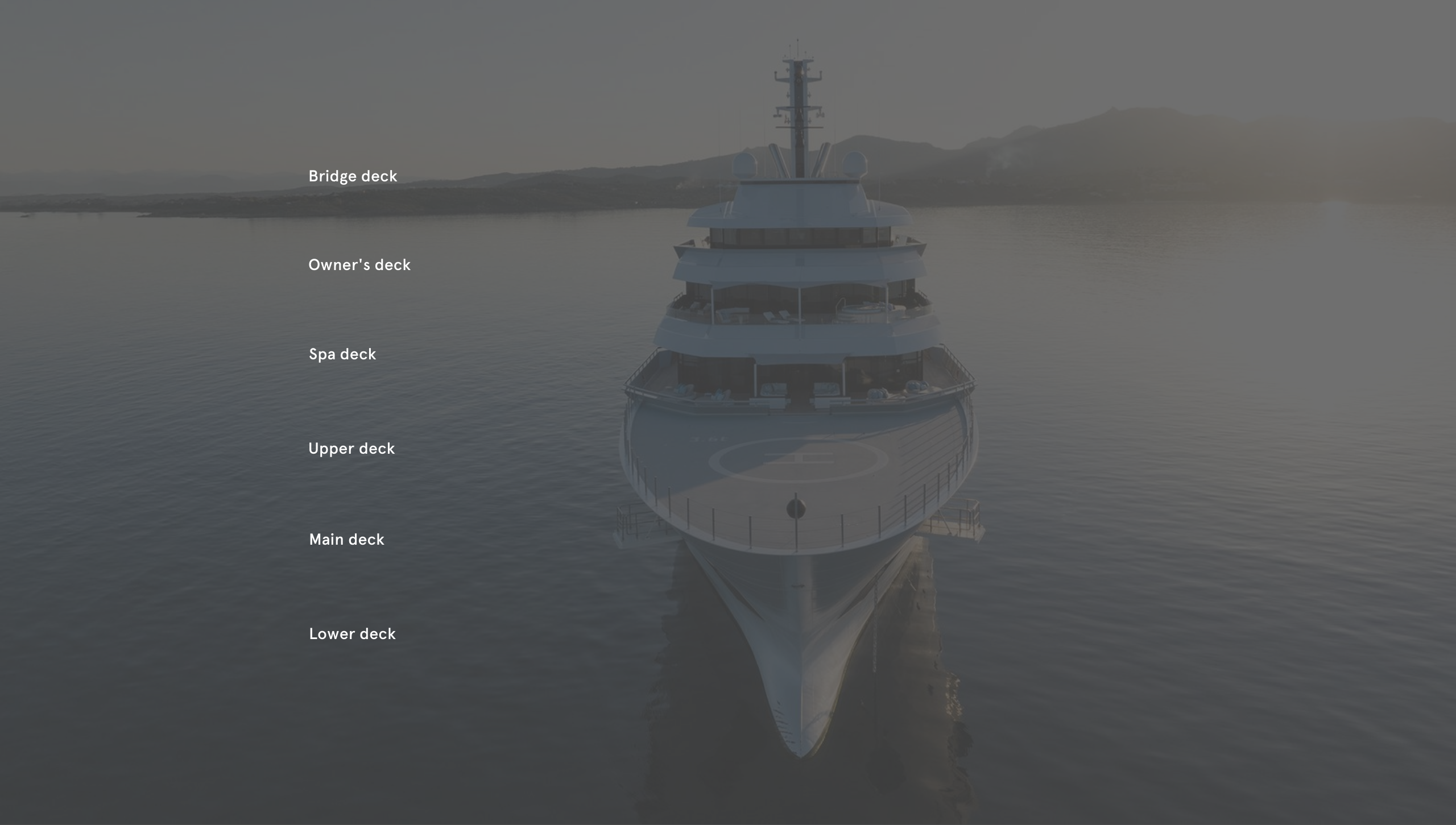
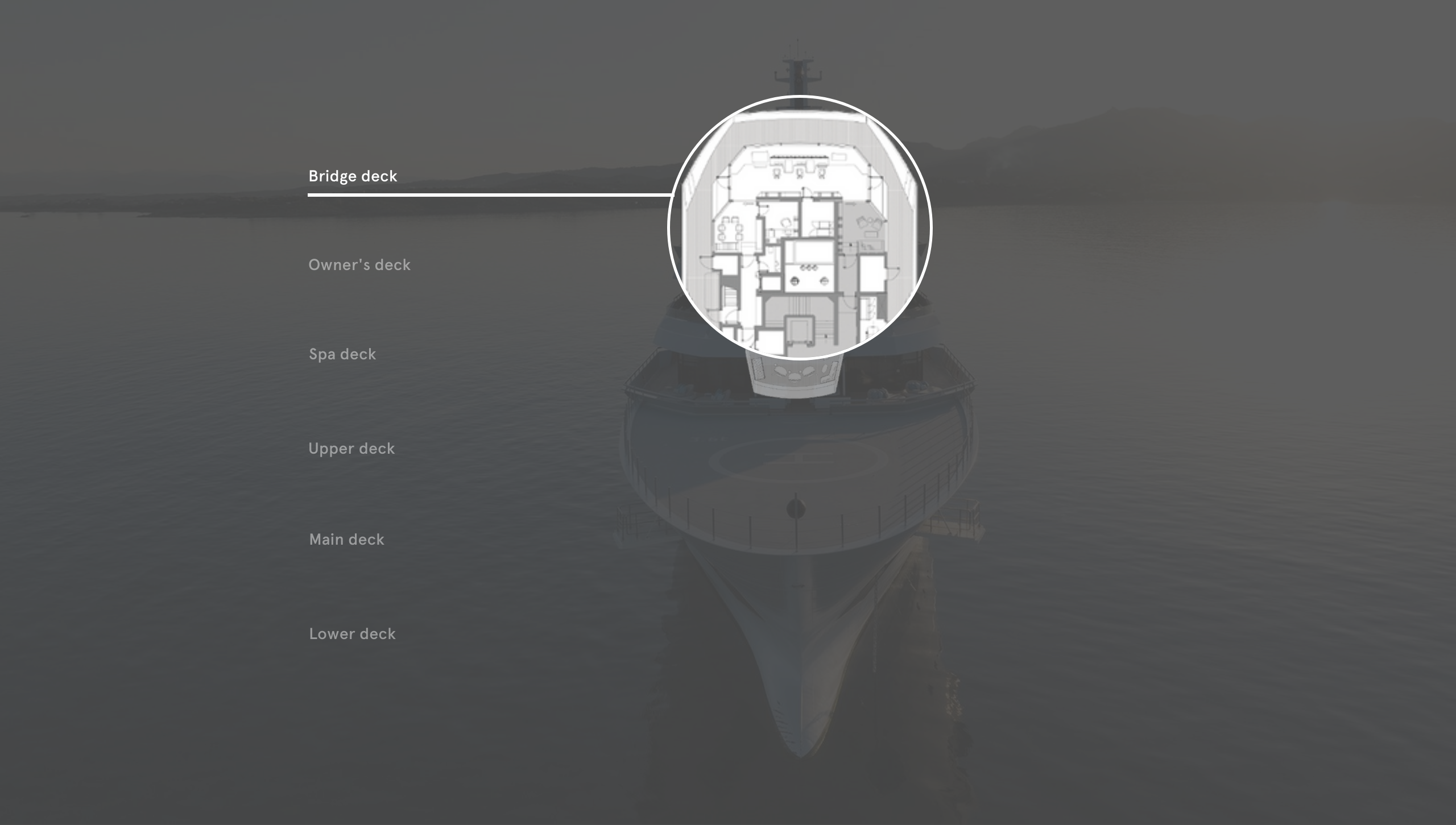
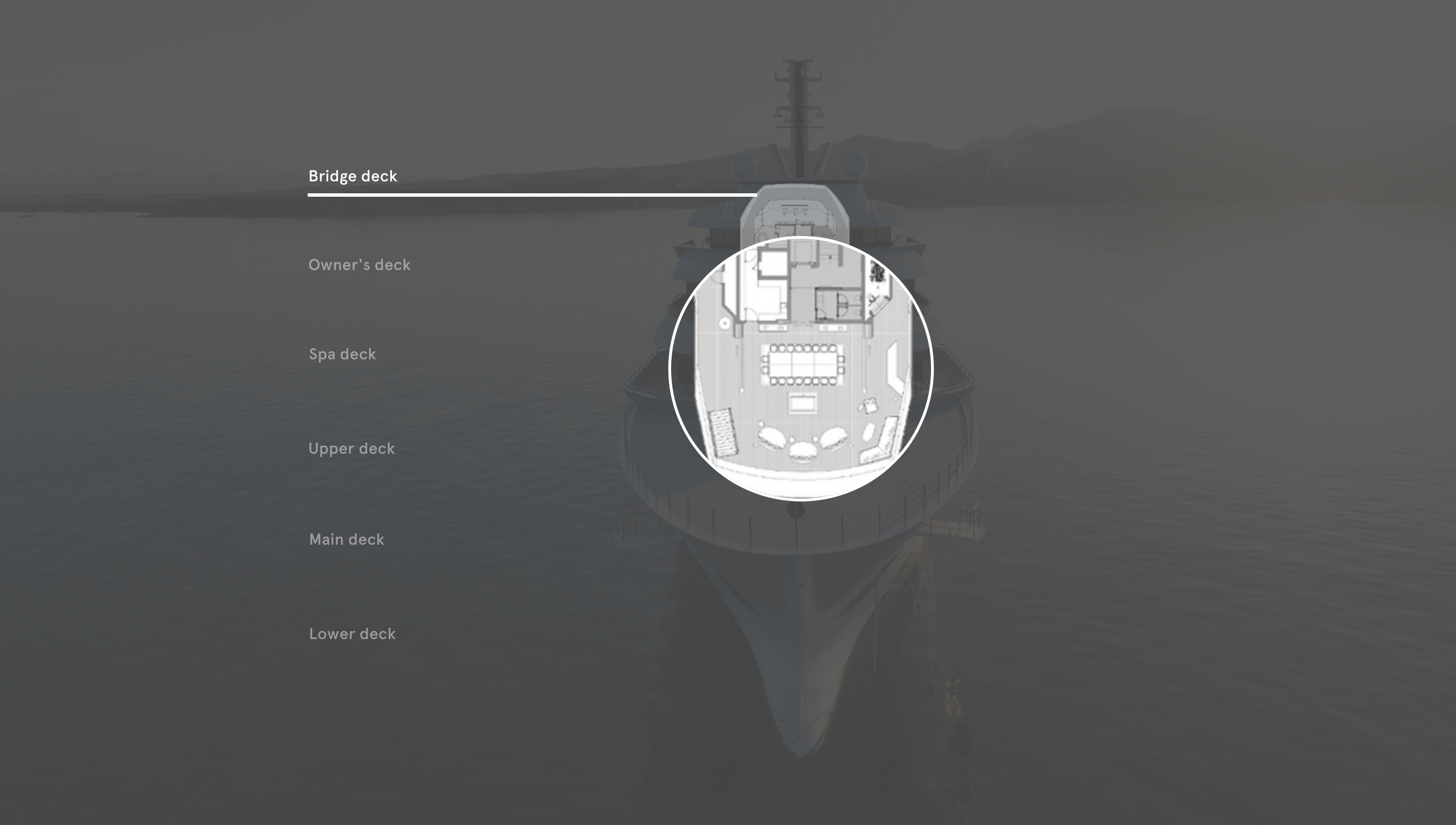
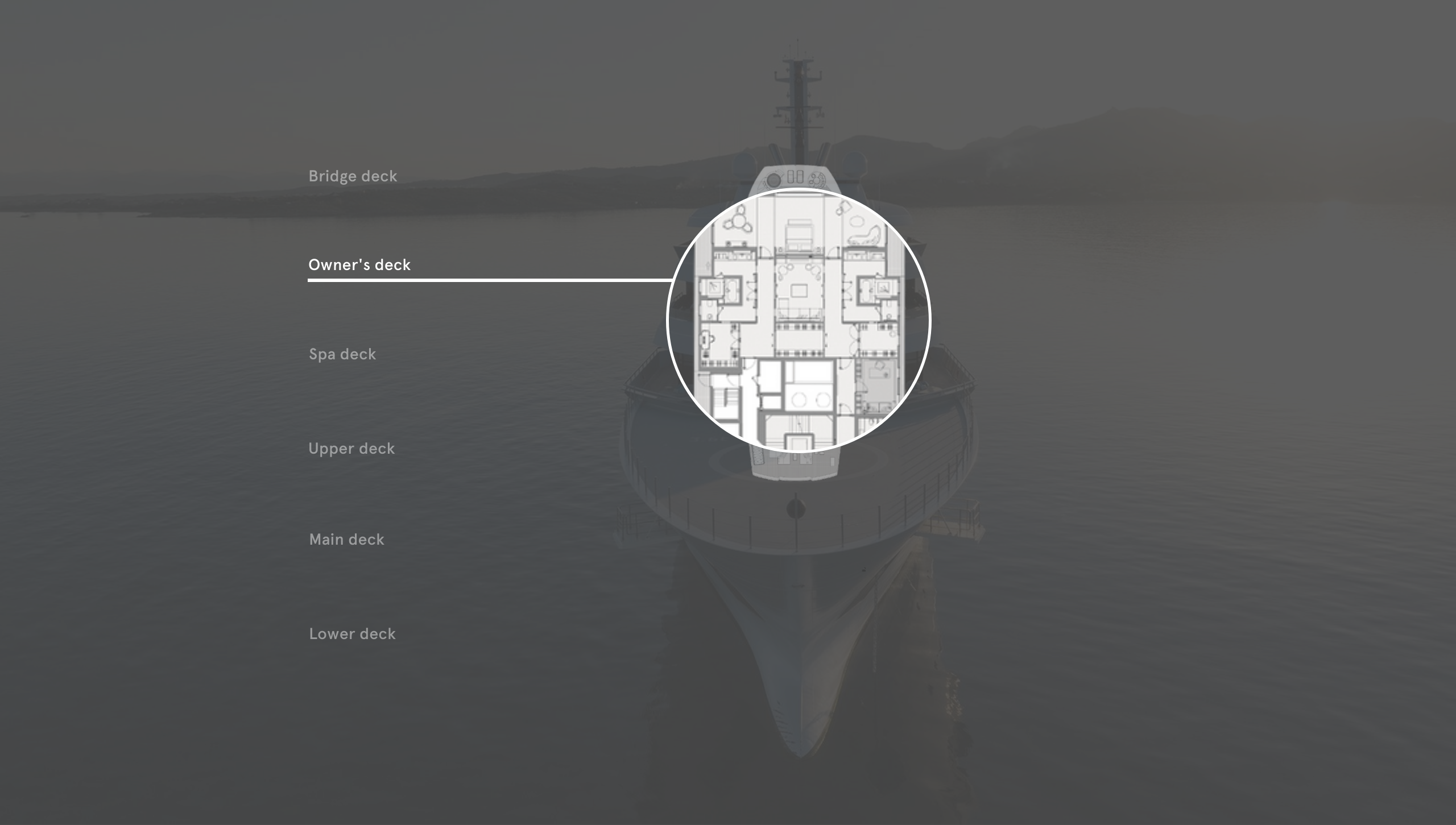
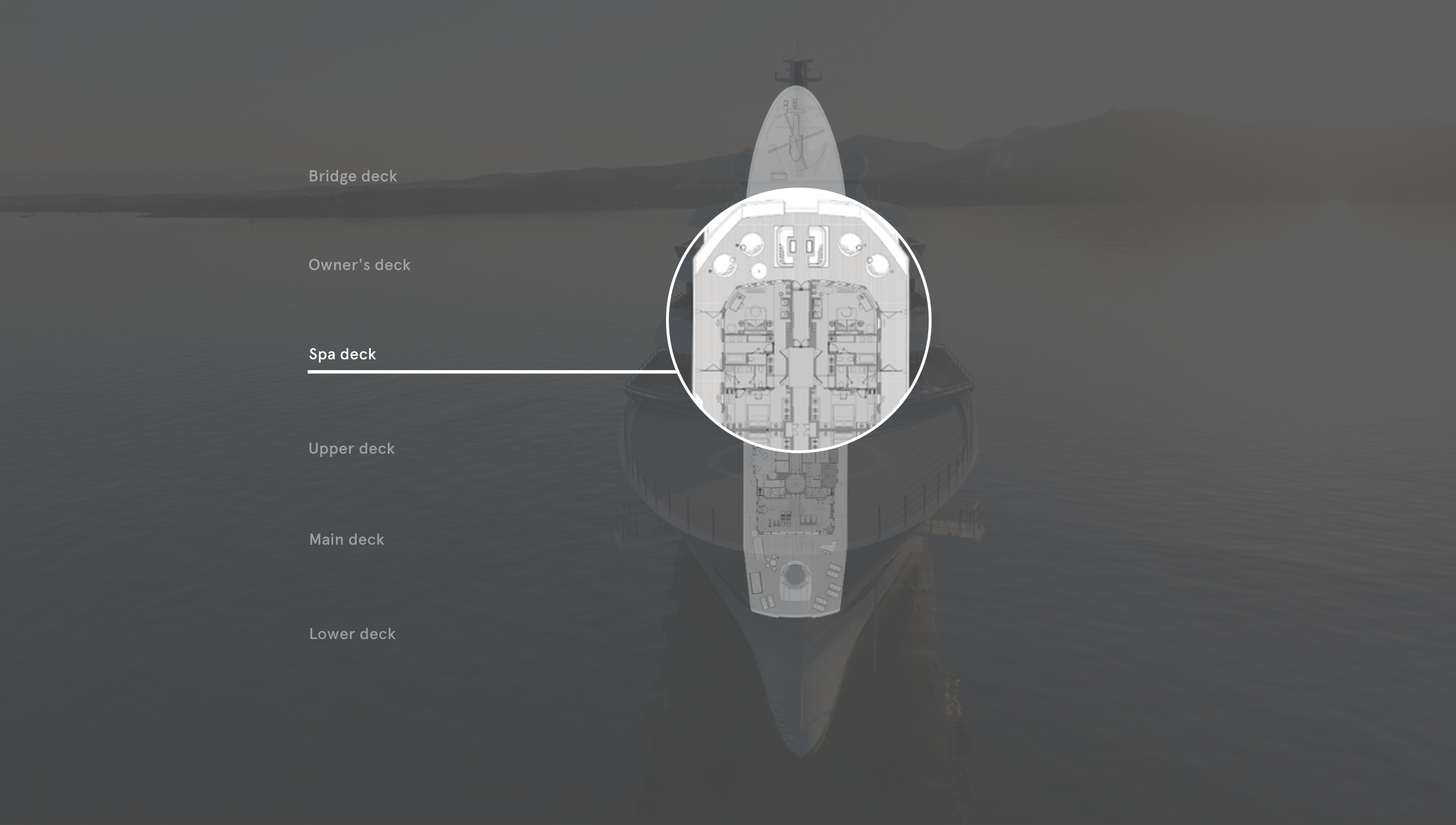
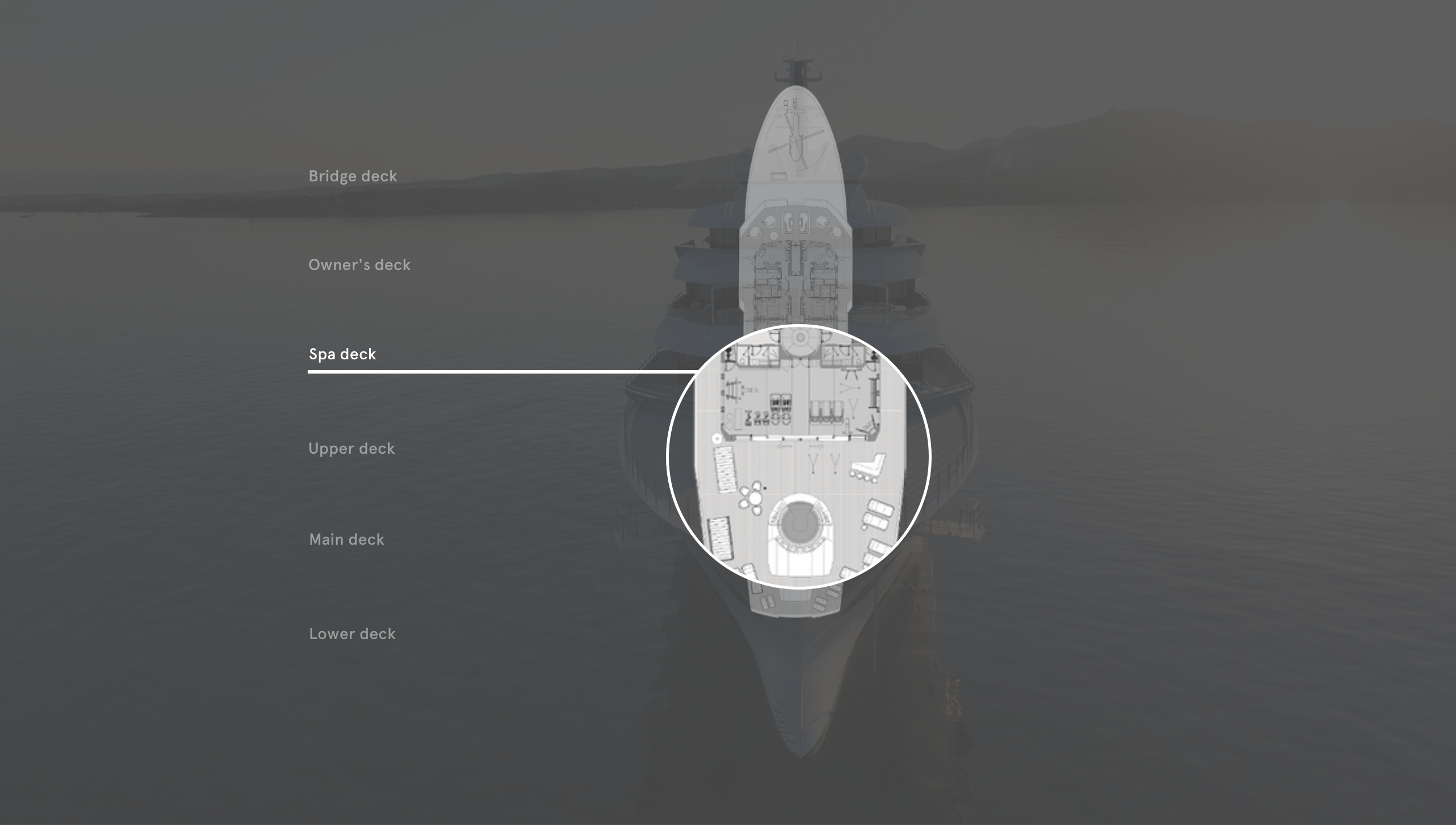
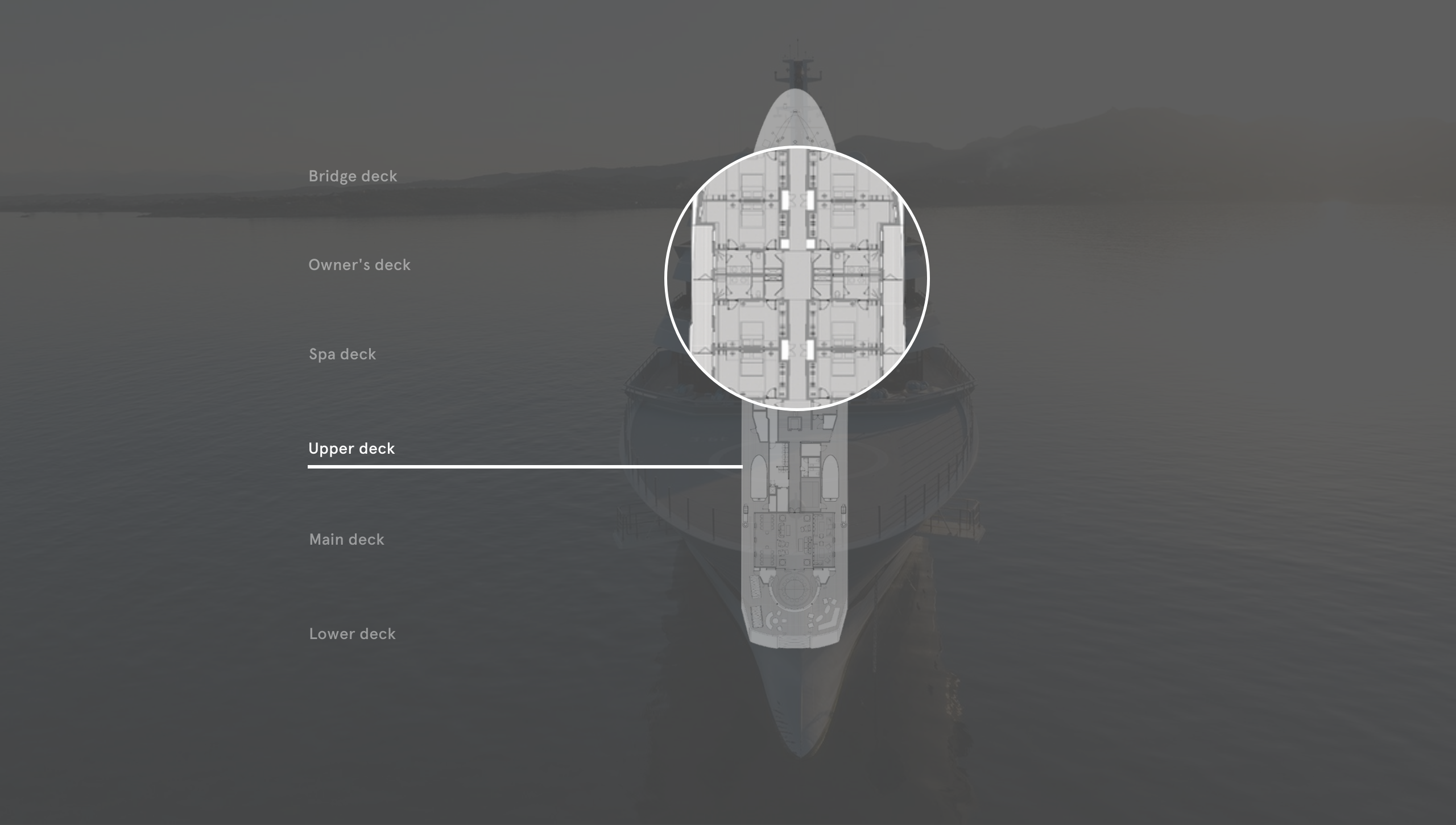
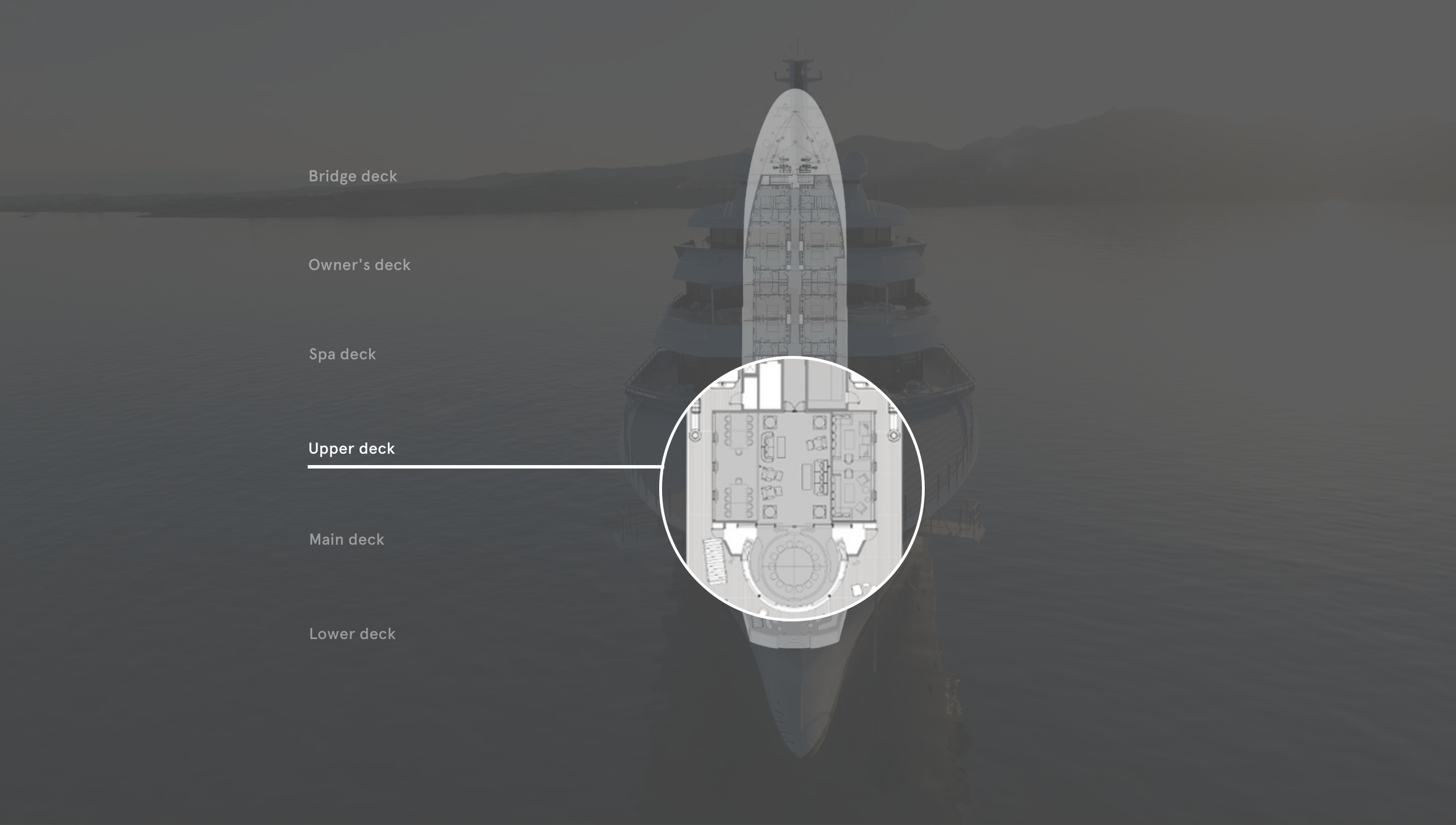
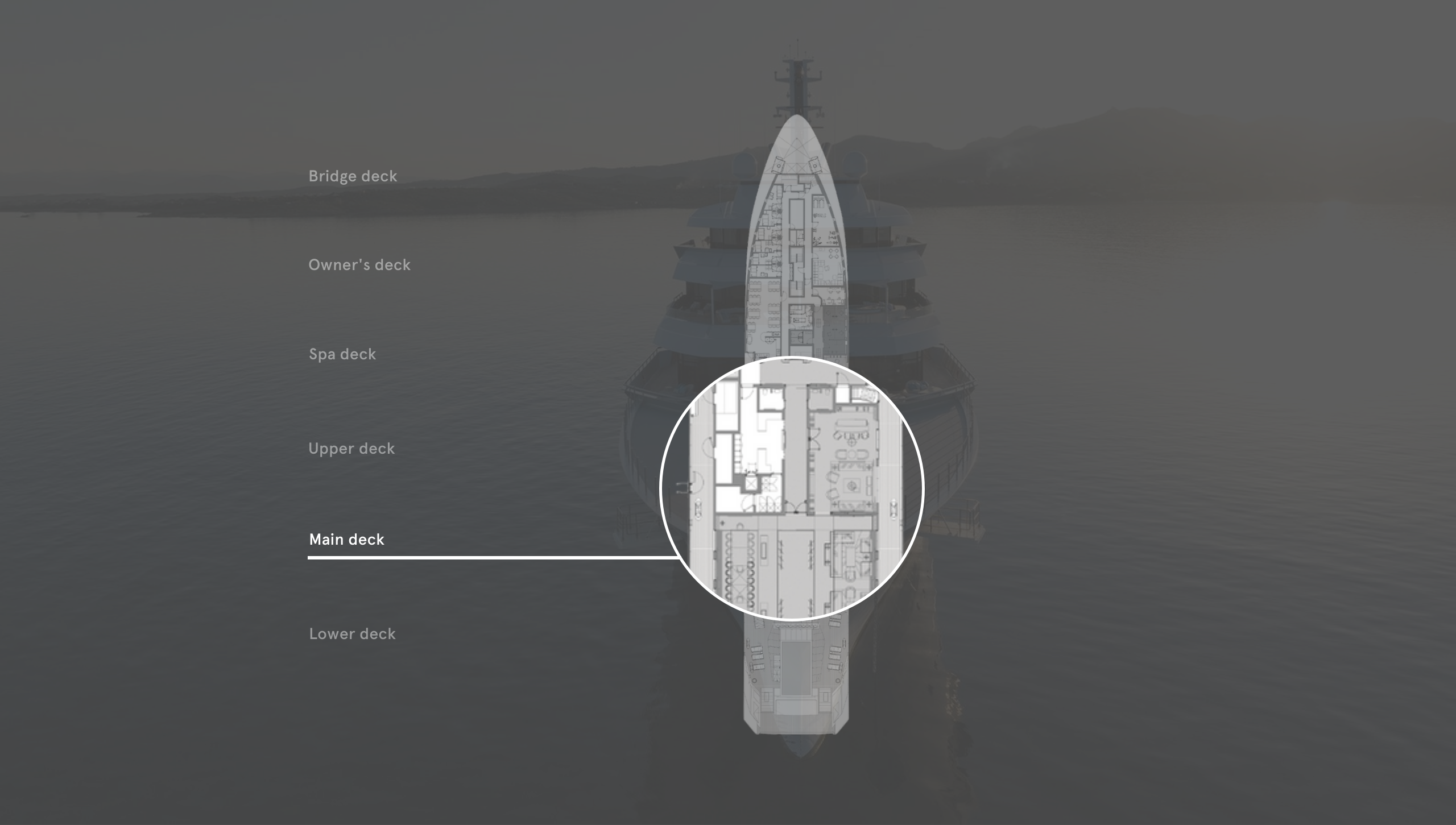
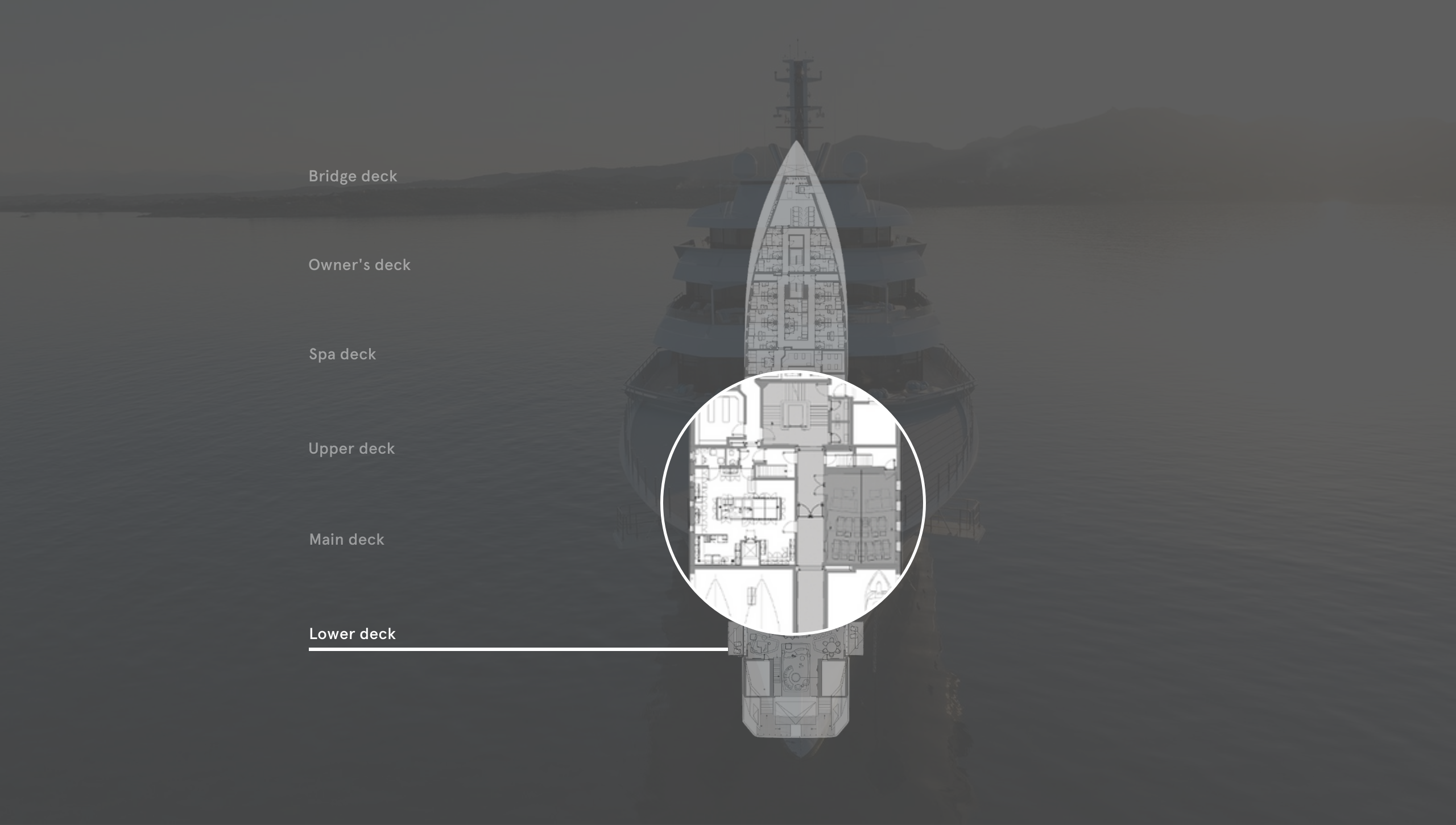
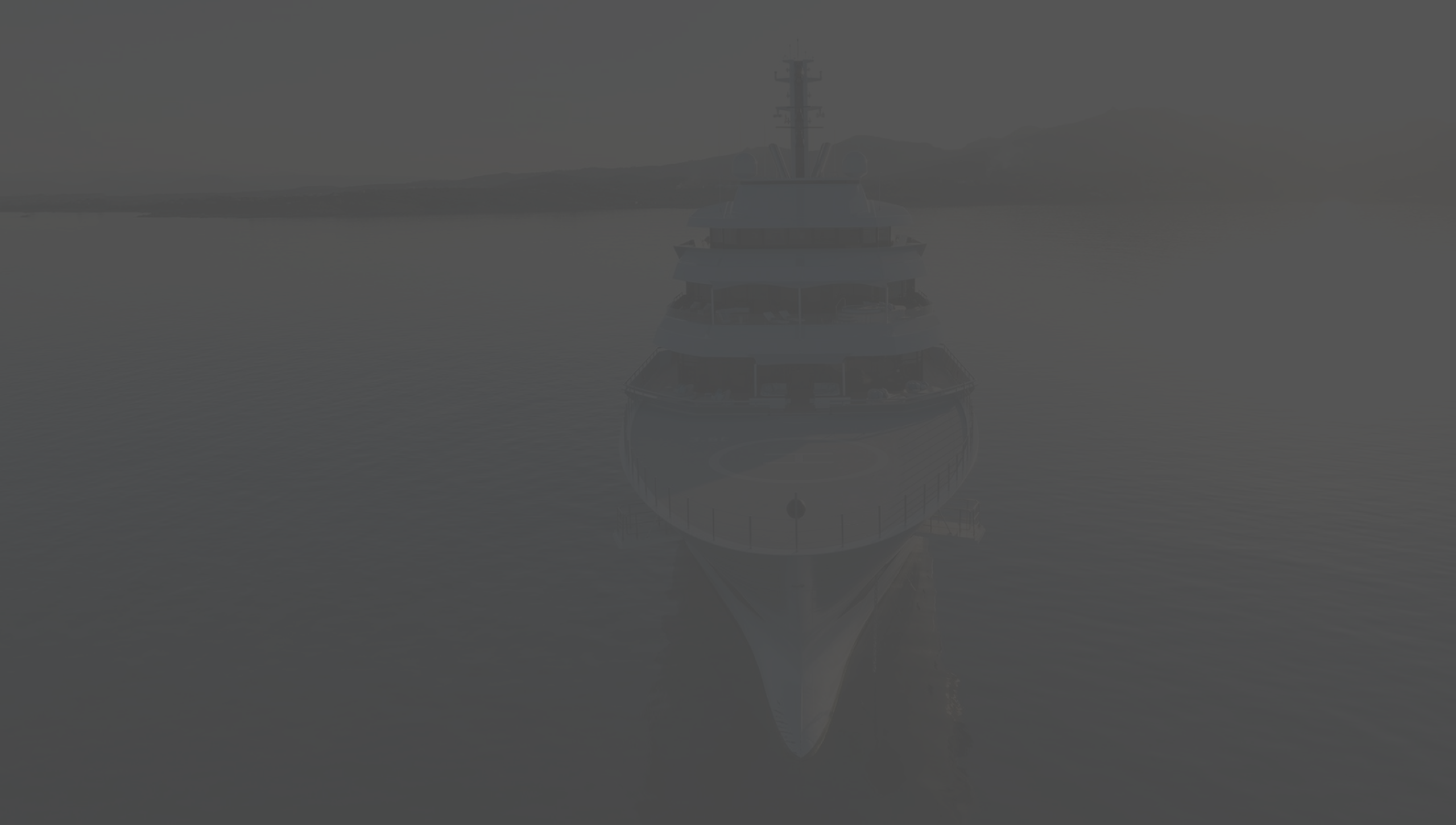
The bridge has an especially lofty view
Up to 20 guests can dine al fresco on the bridge deck
Keeping the TV out of the cabin, a media lounge sits between the his-and-hers bathrooms in the owner's suite
The forward guest cabins can be joined with those just aft to create vast VIP suites
Naturally the spa deck would include a large spa pool, adjacent to the gym and wellness amenities
Guest cabins have doors that open to side deck balconies
This upper deck's lounge "floats" over the double-height main-deck saloon
This jazz bar offers an additional cosy spot to convene
A cinema is tucked away at the bottom of the boat
LOA 112m | Gross tonnage |
LWL 98.4m | Engines |
Beam 18m | Propulsion |
Draught (full load) | Generators |
Speed (max/cruise) | Range at 12 knots |
Fuel capacity | Tenders |
Freshwater capacity | Owners/guests 36 |
Crew 45 | Construction |
Classification | |
Naval architecture | Builder/year |
Exterior styling and interior design Bannenberg & Rowell Design | For charter |


